Riva Yachts: how one Italian family created a nautical legend
By paula reynolds | May 2, 2021
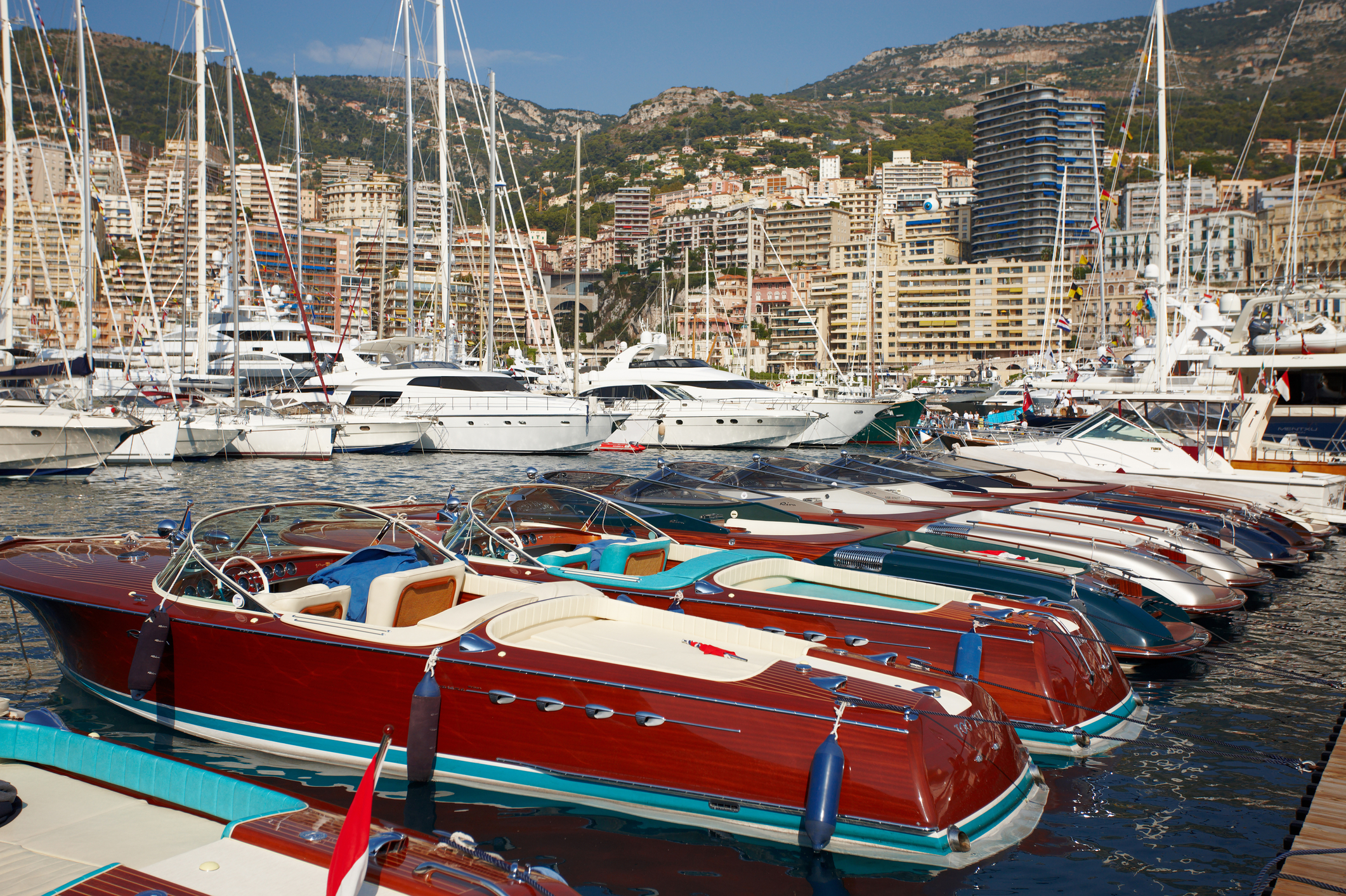
Sophia Loren had one. So did Anita Eckberg and Sean Connery…as did violet-eyed Liz. Brigitte Bardot’s had zebra print seats, and even George Bush was often spotted in his, breaking waves in the Hamptons. They’ve always been the nautical epitome of cool — and we’re not talking about the owners, but of the craft… the 100% Italian built Riva yacht .
Sleek, sexy, oh-so Italian…these streamlined vessels are known throughout the nautical world for their extraordinary quality, unforgettable design, and well…for having a suave factor that would be off the charts if suave charts existed. Even if you’re not familiar with the name, Riva yachts might hold a spot in your subconscious. Just for a second, visualize a bevy of the rich and famous motor-boating across an Italian lake, Prosecco in hand, or maybe a pulse pounding James Bond clip, our hero soaring over breaking waves as he escapes the ire of his latest nemesis. Odds are your imagination included a Riva built boat.
The Riva name is synonymous with luxury and glamour in the boat world, a brand that defies being classified as “just” a watercraft. It might even be more of a zeitgeist of ideology, of concept, of beauty, a melding of style and function that make Riva one of the most desirable yacht names around.
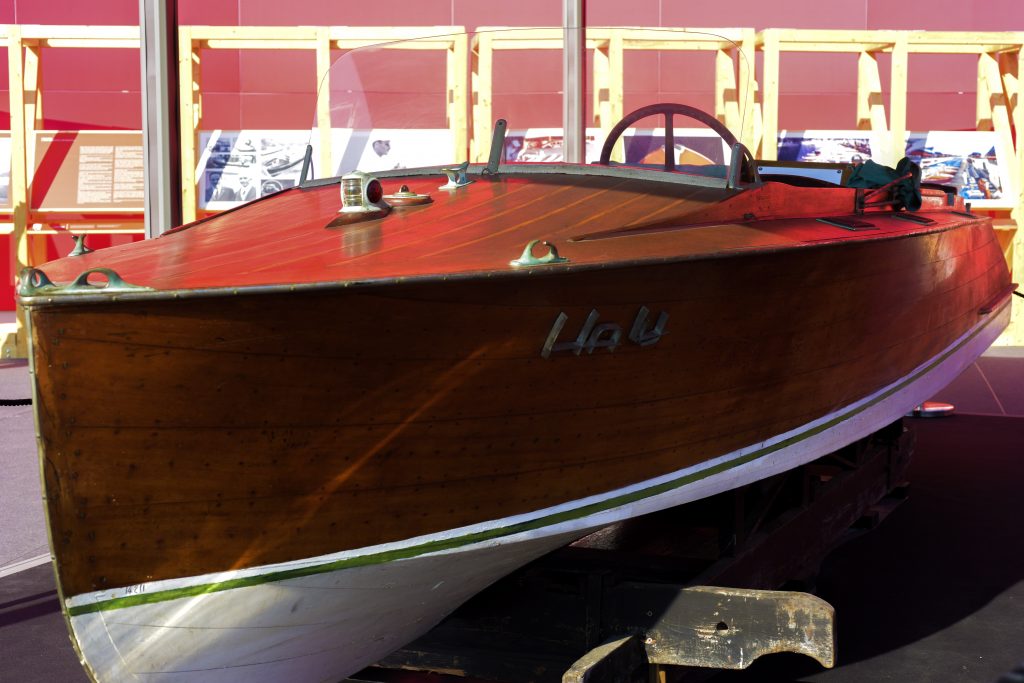
It’s a remarkable story of serendipity and talent that led to the birth of Riva boats. While Carlo Riva (1922-2017) is considered the father of classic contemporary Riva watercraft, had it not been for a run of bad weather on the banks of Lake Iseo in 1842, Sophia would’ve had to settle for a much less classy ride over her Italian lakes.
Heavy rains pummeled the small lakeside town of Sarnico , forcing the River Oglio from its banks. As flooding torrents scoured the village, they carried with them the small fleet of fishing vessels, tumbled about like children’s toys. The humble boats experienced severe damage; immediate help was needed and found through the expertise of a young boatwright by the name of Pietro Riva . Newly arrived from Laglio, Riva quickly set to work repairing and refitting the vessels with skill and quality. His craftsmanship earned the village’s admiration and trust, and eventually Riva opened his own shipyard on the Sarnico shoreline. Pietro’s early production featured quality battel da pesca (fishing boats) and canotto da passeggio (pleasure craft) to suit the needs of the locals, but as his young family grew, so did his vision for his small company.
Pietro’s mastery of boatbuilding was the beginning of a legendary line of shipwrights. His son Ernesto introduced power combustion engines, a forward-thinking step that brought the latest mechanical innovations to the business. His insight introduced not only speedier transportation of goods over the lakes, but the launch of nautical tourism, as well. Ernesto’s own motorboat prototype was a success…and a lot of fun; why not offer tourists the chance to experience the wind, waves, and sights that he was enjoying?
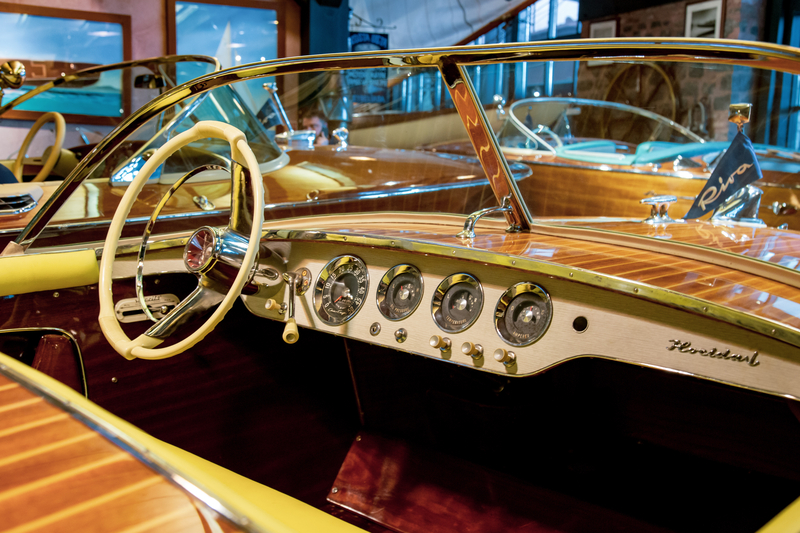
Riva’s visionary heritage continued when Ernesto’s son Serafino took the helm, bringing a major shift to the boatyard. It was after World War I and Italy was ready for distraction. Capitalizing on this, Serafino built and promoted high speed pleasure boats. Equipped for speed and agility, Riva power boats became the hot rod of the Italian lakes. Serafino’s designs quickly set the standard for the popular sport of speedboat racing in the 1920s and 1930s. Riva’s successful incorporation of efficient design and high-powered engines earned fame through multiple wins and titles in Italy and around the world.
“I want to build boats my own way I told my father…I started production in 1950 with six months of testing…It was the happiest day of my life.” ~ Carlo Riva
It wasn’t until Carlo Riva , son of Serafino, took the helm of Riva, however, that the seismic shift in production — and notoriety — began. With the skill, training, DNA, and drive of the Riva dynasty under his skin, Carlo revolutionized Riva design. After some serious head-butting with his father Serafino — who saw no need to change the line’s traditional success — Carlo succeeded in forging ahead with his vision for a sleek, immaculately built boat featuring flawless functionality and glamorous visual appeal: the nautical version of Italian flair and desirability. A new manufacturing facility was constructed in 1954 on the shores of Lake Iseo fusing state-of-the art innovation with Riva’s famed tradition for minute attention to detail and quality. Carlo’s vision set into motion Riva’s golden age of luxury watercraft; Riva yachts quickly became the coveted status symbol for those with an eye for ultimate fashion and function.
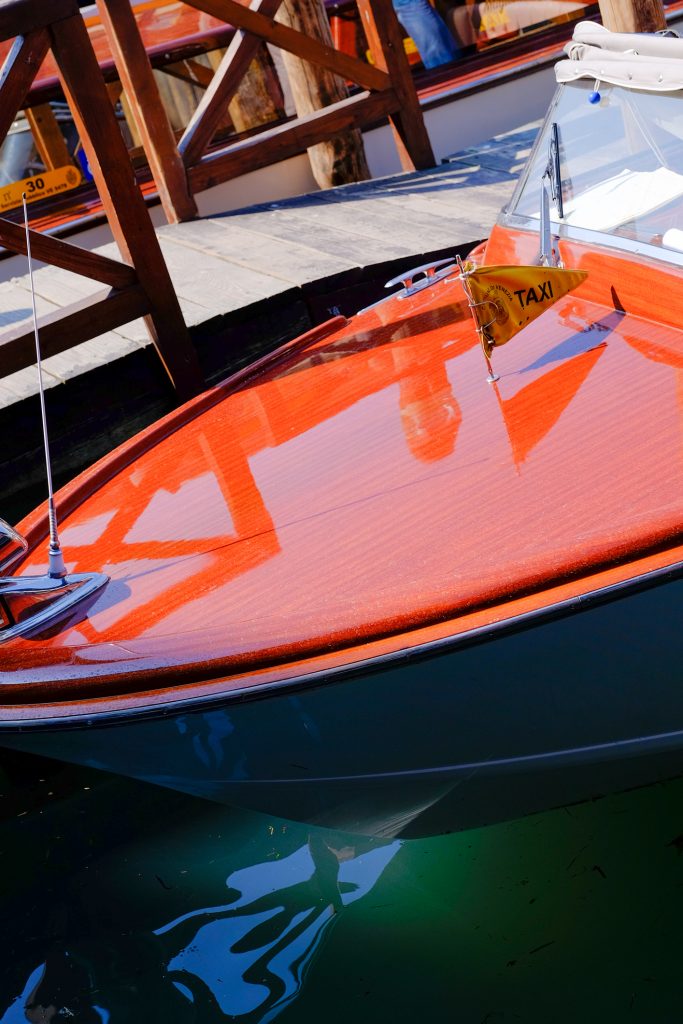
The breakthrough, however, that imbedded the iconic Riva style in modern awareness came about in 1962 with the launch of the Acquarama. Using the design protocol of his highly popular Tritone , Carlo reimagined the boat to feature roomier passenger space, a sun deck that seemed to beg for bathing beauties, and other innovations that set precedents in the boating world. His signature feature of turquoise blue upholstery with a matching wheel was the cherry on top. Named #1 of the Top 100 Best Boats Ever by “Motorboat & Yachting Magazine” and “Most beautiful boat in the World” by the International Press, this “Ferrari of the boat world” still quickens the pulse in many whenever she shows up in movies or commercials — or lakeside if you’re lucky enough to witness one slicing through the blue.
Carlo sold his company to an American firm in 1969 yet remained active for several more years. A succession of non-Italian owners finally came full circle in 2000 when the Italian Ferretti Group purchased Riva Yachts. Active in production today, Carlo’s imprint remains strong within the company, evident through the breath-taking style, consummate quality, and suave elegance permeating every Riva boat from cruiser to mega-yacht.
Riva Yachts, a name synonymous with Italian flair and elegance, remains one of the most coveted brands today. Even if owning one is out of reach, it’s possible to get up close and personal with a visit to the Riva Yacht factory in Sarnico. Standing next to Ernesto’s first motorboat, or perhaps feeling your pulse quicken as you admire the Aquarama #784, the last classic model off the production line in 1996, can quicken the pulse of any fan of the beauty of Italian design and innovation. Carlo’s spirit is alive and well on the shores of his beloved Sarnico.
“… Designed with love, pure and strong like a pedigree horse. Unforgettable!” ~ Carlo Riva
Sophia Loren ne aveva uno. Anche Anita Eckberg e Sean Connery… come anche Liz dagli occhi viola. Quello di Brigitte Bardot aveva sedili zebrati, e persino George Bush è stato spesso visto a bordo del suo, mentre navigava negli Hamptons. Sono sempre stati l’epitome nautica del cool – e non stiamo parlando dei proprietari, ma dell’imbarcazione… lo yacht Riva costruito al 100% in Italia. Eleganti, sexy, così italiani… queste imbarcazioni aerodinamiche sono conosciute in tutto il mondo nautico per la loro straordinaria qualità, il design indimenticabile, e beh… per avere un fattore di soavità che sarebbe fuori dalle classifiche se esistessero classifiche di soavità. Anche se il nome non vi è familiare, gli yacht Riva potrebbero avere un posto nel vostro subconscio. Solo per un secondo, visualizzate un gruppo di ricchi e famosi che navigano a motore su un lago italiano, Prosecco alla mano, o magari un filmato di James Bond, con il nostro eroe che si libra sulle onde che si infrangono mentre sfugge all’ira della sua ultima nemesi. È probabile che la vostra immaginazione includa una barca costruita da Riva. Il nome Riva è sinonimo di lusso e glamour nel mondo delle barche, un marchio che sfida la classificazione di “semplice” imbarcazione. Potrebbe anche essere più dello spirito del tempo, dell’ideologia, del concetto, della bellezza, una fusione di stile e funzione che rendono Riva uno dei nomi più desiderabili di yacht. È una straordinaria storia di serendipità e talento quella che ha portato alla nascita delle barche Riva. Mentre Carlo Riva (1922-2017) è considerato il padre dei classici motoscafi Riva contemporanei, se non fosse stato per un periodo di maltempo sulle rive del lago d’Iseo nel 1842, Sophia avrebbe dovuto accontentarsi di un giro molto meno elegante sui laghi italiani. Forti piogge colpirono la piccola città lacustre di Sarnico, facendo uscire dalle sponde il fiume Oglio. Mentre i torrenti inondavano il villaggio, portarono con sé la piccola flotta di pescherecci, trascinati come giocattoli per bambini. Le umili barche subirono gravi danni; fu necessario un aiuto immediato, che fu trovato grazie alla competenza di un giovane maestro d’ascia di nome Pietro Riva. Appena arrivato da Laglio, Riva si mise subito al lavoro per riparare e sistemare le barche con abilità e qualità. La sua abilità artigianale guadagnò l’ammirazione e la fiducia del villaggio, e alla fine Riva aprì il suo cantiere navale sulla costa di Sarnico. La produzione iniziale di Pietro comprendeva battelli da pesca e canotti da passeggio di qualità per soddisfare le esigenze della gente del posto, ma quando la sua giovane famiglia crebbe, crebbe anche la visione della sua piccola azienda. La maestria di Pietro nella costruzione di barche fu l’inizio di una linea leggendaria di maestri d’ascia. Suo figlio Ernesto introdusse i motori a combustione, un passo lungimirante che portò le ultime innovazioni meccaniche al business. La sua intuizione introdusse non solo un trasporto più veloce delle merci sui laghi, ma anche il lancio del turismo nautico. Il prototipo di motoscafo di Ernesto fu un successo… e molto divertente: perché non offrire ai turisti la possibilità di sperimentare il vento, le onde e i panorami di cui lui godeva? L’eredità visionaria di Riva continuò quando il figlio di Ernesto, Serafino, prese il timone, portando un grande cambiamento nel cantiere. Era il primo dopoguerra e l’Italia era pronta a distrarsi. Capitalizzando questo cambiamento, Serafino costruì e promosse barche da diporto ad alta velocità. Equipaggiate per la velocità e l’agilità, le barche a motore Riva divennero l’hot rod dei laghi italiani. I progetti di Serafino stabilirono rapidamente lo standard per il popolare sport delle gare di motoscafi negli anni ’20 e ’30. La riuscita incorporazione da parte di Riva di un design efficiente e di motori ad alta potenza si guadagnò la fama attraverso molteplici vittorie e titoli in Italia e nel mondo. “Voglio costruire barche a modo mio, dissi a mio padre… Ho iniziato la produzione nel 1950 con sei mesi di prove… È stato il giorno più felice della mia vita”. ~ Carlo Riva Fu solo quando Carlo Riva, figlio di Serafino, prese il timone della Riva, però, che iniziò la svolta decisiva nella produzione – e nella notorietà. Con l’abilità, la formazione, il DNA e la grinta della dinastia Riva nella pelle, Carlo rivoluzionò il design Riva. Dopo qualche scontro con il padre Serafino – che non vedeva la necessità di cambiare il tradizionale successo della linea – Carlo riuscì a portare avanti la sua visione di una barca elegante, costruita in modo impeccabile e con un appeal visivo glamour: la versione nautica del fascino italiano e della desiderabilità. Nel 1954 fu costruito un nuovo stabilimento di produzione sulle rive del lago d’Iseo, fondendo l’innovazione allo stato dell’arte con la famosa tradizione Riva di attenzione al dettaglio e alla qualità. La visione di Carlo mise in moto l’età dell’oro delle imbarcazioni di lusso Riva; gli yacht Riva divennero rapidamente l’ambito status symbol per coloro che erano attenti alla moda e alla funzionalità. La svolta, tuttavia, che incastrò l’iconico stile Riva nella consapevolezza moderna avvenne nel 1962 con il lancio dell’Acquarama. Usando il protocollo di design del suo popolarissimo Tritone, Carlo reimmaginò la barca con uno spazio più ampio per i passeggeri, un ponte sole che sembrava implorare bellezze da bagno, e altre innovazioni che stabilirono dei precedenti nel mondo della nautica. La sua firma, tappezzeria blu turchese con una ruota abbinata, fu la ciliegina sulla torta. Nominata n. 1 fra le 100 migliori barche di sempre dalla rivista “Motorboat & Yachting Magazine” e “la più bella barca del mondo” dalla stampa internazionale, questa “Ferrari del mondo delle barche” fa ancora battere forte il cuore a molti ogni volta che appare nei film o nelle pubblicità – o in riva al lago se si è abbastanza fortunati da vederne una che sfreccia nel blu. Carlo vendette la sua compagnia a un’azienda americana nel 1969, ma rimase attivo ancora per diversi anni. Una successione di proprietari non italiani ha finalmente chiuso il cerchio nel 2000, quando il Gruppo Ferretti, italiano, ha acquistato Riva Yachts. Attivo oggi nella produzione, l’impronta di Carlo rimane forte all’interno dell’azienda, evidente attraverso lo stile mozzafiato, la qualità tradizionale e la soave eleganza che permea ogni barca Riva, dal cruiser al mega-yacht. Riva Yachts, sinonimo di fascino ed eleganza italiana, rimane uno dei marchi più ambiti oggi. Anche se possederne uno non è alla portata di tutti, è possibile avvicinarsi a questo marchio con una visita alla fabbrica Riva Yachts di Sarnico. Stare accanto al primo motoscafo di Ernesto, o magari sentire le pulsazioni accelerare mentre si ammira l’Aquarama #784, l’ultimo modello classico uscito dalla linea di produzione nel 1996, può emozionare qualsiasi fan della bellezza del design e dell’innovazione italiana. Lo spirito di Carlo è vivo e vegeto sulle rive della sua amata Sarnico. “…Progettata con amore, pura e forte come un cavallo di razza. Indimenticabile!” ~ Carlo Riva

26 issues of L’Italo Americano digital edition

Support L’Italo Americano
If you’re able to, please support L’Italo Americano today from as little as $1.

Weekly Newsletter
Da Brigitte Bardot a Sophia Loren, tutti han ceduto al fascino dello yatch Riva
Acquarama è il modello che oggi viene raccontato in un volume speciale.
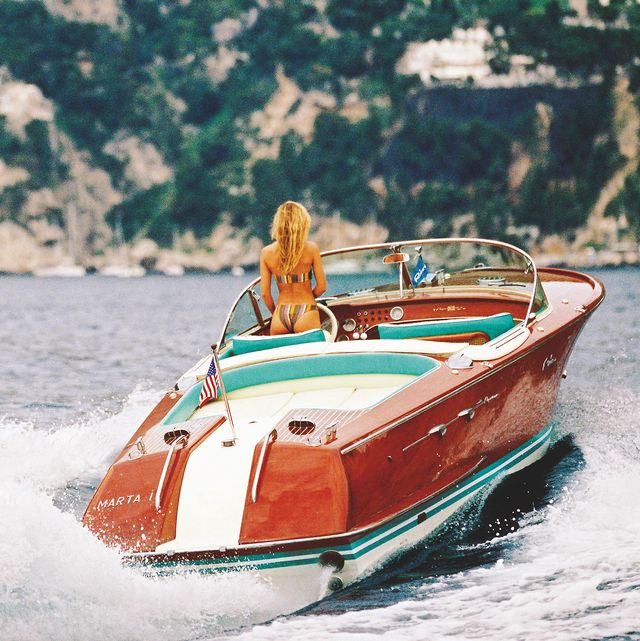
Quando si parla di glamour e di stile in mare, non c'è niente di più attraente dell'Aquarama. Ideato dal mitico Carlo Riva, il famoso motoscafo in legno è stato pensato per portare il lusso nel mondo delle imbarcazioni. In breve è diventato un'icona del design italiano. A raccontarne la storia è ora il nuovo libro Riva Aquarama , edito da Assouline, che ne celebra, con bellissime immagini, il sessantesimo anniversario. Amato per le sue linee pulite, la sensualità del mogano, i dettagli cromati scintillanti e la tappezzeria pregiata, l'Aquarama riflette, oggi come ieri, l'ottimismo e l’eleganza della Dolce Vita dell'Italia dei primi anni Sessanta. Il primo modello, che era un’evoluzione funzionale del modello Tritone, un altro motoscafo prodotto da Riva, fu lanciato dall'ingegnere Carlo Riva nel 1962 e venne prodotto per circa trent’anni, fino al 1996. Il suo nome s’ispira al cinerama, un sistema di ripresa e proiezione su uno schermo curvo, la cui forma è ripresa dal parabrezza.
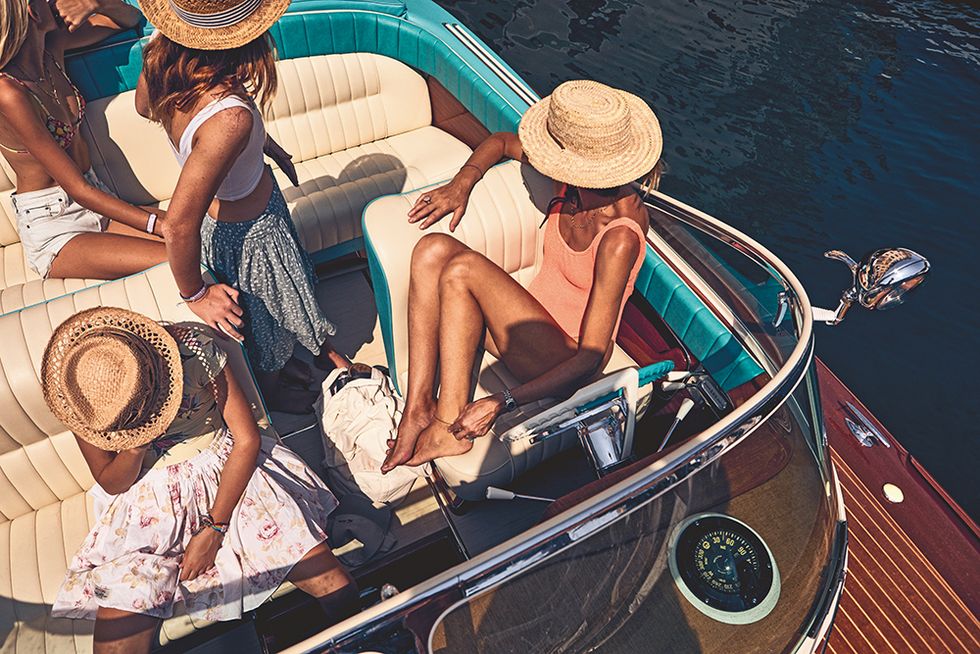
Quando si dice Aquarama, vengono subito in mente le decine di personaggi famosi fotografati a bordo della “Rolls-Royce del mare”, "la Ferrari del mare", "lo Stradivari delle barche", o ancora "la regina della Costa Azzurra”, come viene soprannominato il mitico scafo, uno dei più affascinanti motoscafi al mondo. Amato dalle star del cinema, dai grandi industriali, dalle famiglie reali e dai capi di stato, la leggendaria imbarcazione è da sempre attraccata ai moli privati di ville da sogno, residenze di charme e hotel di lusso. Il Riva che solca le acque della Costa Azzurra e naviga tra le isole più mondane d'Europa, con bellezze in bikini stese al sole, è la cartolina perfetta delle estati vissute all’insegna del glamour autentico. Da Brigitte Bardot a Sophia Loren, Gunter Sachs e la famiglia reale di Monaco, lo Scià di Persia, il Principe Ranieri, Aristotele Onassis, non si contano le celebrità che sono rimasti incantati dall'incantesimo di Aquarama. "Quel senso di esplorazione negli ampi spazi marini, ecco cos'è il Riva per me: la libertà di andare ovunque. Il mezzo perfetto per goderti il Mediterraneo, o qualunque mare del mondo", afferma il Principe Alberto di Monaco, grande appassionato.
Il motoscafo è diventato una star grazie all'immagine sfavillante data dagli armatori del jet set e dalle celebrità del cinema. Anita Ekberg era una grande fan e si faceva fotografare a bordo del suo Tritone. Brigitte Bardot aveva un Super Florida e uno Junior. Elisabeth Taylor e Richard Burton usavano uno Junior come tender del loro grande yacht. Re Hussein di Giordania ormeggiava a Santa Margherita Ligure il suo Super Aquarama, mentre Gunter Sachs preferiva il porto di St. Tropez. Tom Ponzi acquistò prima un Aquarama e successivamente un Super Aquarama, Ferruccio Lamborghini fece montare sul suo due motori V12 Lamborghini, per sfrecciare in mare. Ma anche Elle Macpherson e George Clooney sono fieri armatori del mitico scafo. “Uscivamo in barca ogni giorno, per nuotare, fare snorkeling e pescare ricci”, racconta Elle Macpherson.
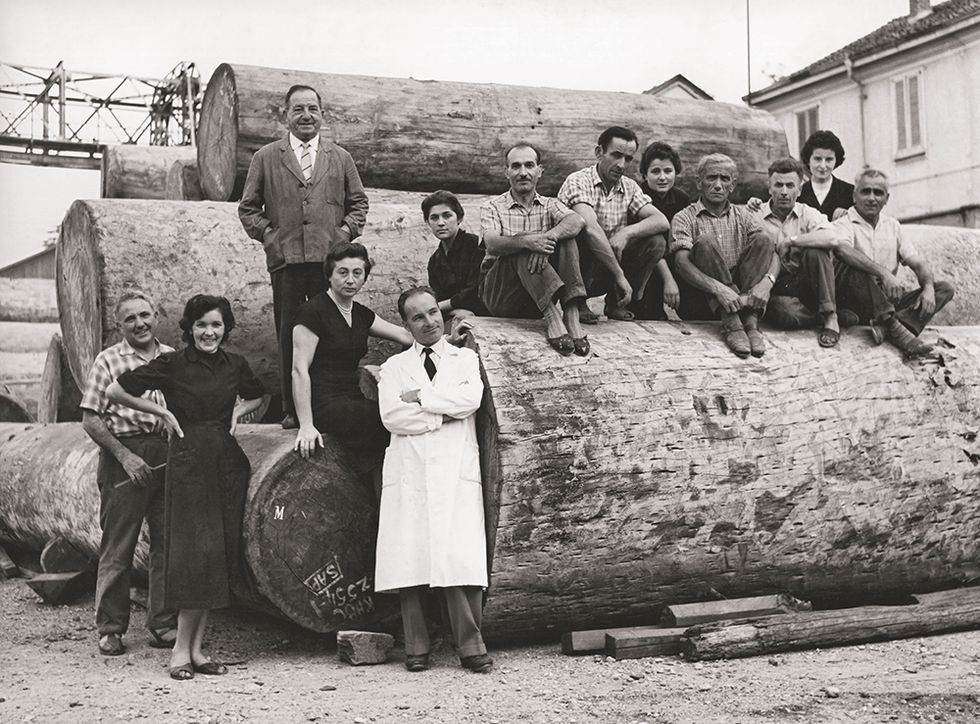
Simbolo di charme, è stato immortalato anche da film e spot. Come l’Aquarama Special guidato da Xenia Onatopp, visto volare nel film GoldenEye. O quello guidato da Vincent Cassel in una scena di Ocean's Twelve. Charlize Theron guidava un Aquarama Super in uno spot per la Martini & Rossi del 1993. E nel 2011 un affascinante Jude Law era al volante di uno Special per la campagna pubblicitaria di Dior. Non è solo una barca, insomma, ma la realizzazione di un sogno. In questo eccezionale omaggio all'Aquarama di Assouline, l'autore Michael Verdon racconta la storia del leggendario scafo, ne fa rivivere il fascino e il puro glamour. E, per gli appassionati, c’è anche un'edizione speciale, presentata in una lussuosa scatola in mogano, che esprime al meglio la bellezza della magnifica imbarcazione. Un modo per offrire a proprietari, collezionisti e appassionati un pezzo del sogno Riva.

Le migliori cose da fare a Nashville
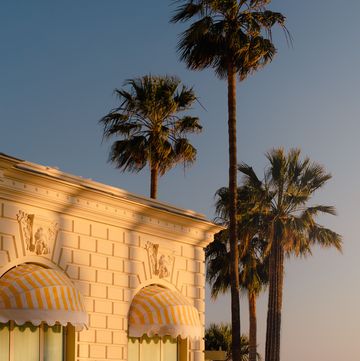
Visitare Cannes aspettando il Festival
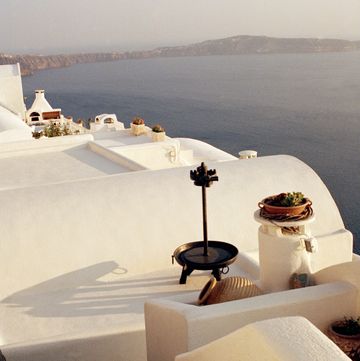
Fuga insolita a Mykonos

10 luoghi da visitare negli Stati Uniti

Le più belle case di lusso degli hotel
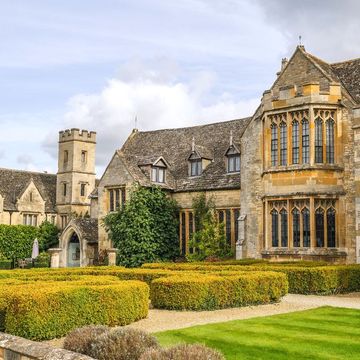
I migliori alberghi per gli amanti dei cavalli
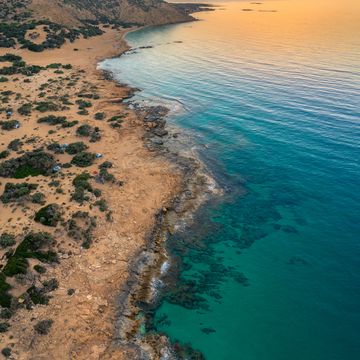
Le isole più insolite da visitare quest’anno

Gli hotel più belli del mondo
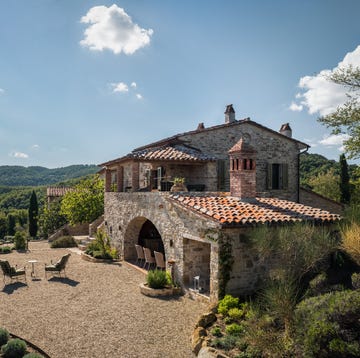
Le ville più belle del mondo
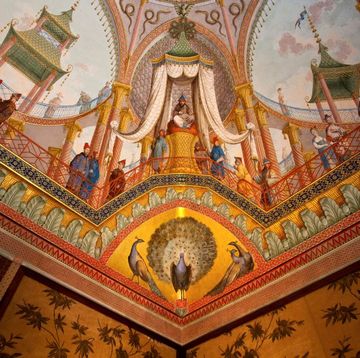
Le case museo italiane da scoprire

10 asciugamani di lusso
Riva: the Origins of the Legend
In 1842, pietro riva founded what was to become a remarkable dynasty of expert craftsmen and designers, pioneers and giants in the history of yachting..
By Museimpresa
1939, left to right, drivers Carmagnani, Guerini, Sestini and Dupuy with Serafino and Carlo Riva.
G.S.C. Riva - Riva boatyard ramps at the Sebino Gran Prix. (1951/1951) Museimpresa
Riva and the origins of the racers legend
Racing boats played an important role in Riva’s evolution. As it does today, racing offered a way to experiment with materials and technologies that would then be adapted and used successfully on recreational boats.
G. S. C. Riva - Serafino Riva and Luigi Calvi on the AZ (Riva hull) (1932/1932) Museimpresa
Charting the course to racing boats
It was from his father that Serafino inherited his passion for boats and engines. He was fascinated by speed on the water and became so involved in the first outboard racing competitions that he entered them as both builder and driver.
G.S.C. Riva - Carlo Pagliano, in a Riva hull with a Johnson engine (1938/1938) Museimpresa
From victory to victory
In the 1920s the Riva Boatyard stopped producing large vessels and focused exclusively on racing boats. Serafino quickly became the benchmark for all the top powerboat racers of the period, building customised boats for them with extraordinary commitment and attention to detail.
Series-produced boats
G.S.C. Riva - The Tritone’s innovative sun pad on the engine compartment cover Museimpresa
The era of Carlo Riva: a legend is born (1950 – 1970)
In 1950, control of the Riva Boatyard was officially transferred to Carlo, Serafino's son, who understood the needs of the time and turned Riva into a synonym for elegance, status and perfection.
G.S.C. Riva - The Tritone on the water Museimpresa
Tritone, 1950
Powerful, safe and fast, but also large in size and spacious, Tritone could be used to go on short cruises in complete safety. 8.02 metres in length and 2.62 in the beam, it could accommodate up to 10 passengers in the cockpit and two below deck in the cabin.
G.S.C. Riva - Aerial photo of an Ariston on the water Museimpresa
Ariston, 1950
Created for more demanding customers, this boat reprised the Corsaro formula but on a larger scale, with a length of 6.52 metres and two rows of seats in the cockpit accommodating six passengers. The lines are essential, measured and without any exaggerated flourishes.
G.S.C. Riva - The Ariston on the water Museimpresa
The 220 hp engine drives the boat to a top speed of about 70 km/h. In 1968, the Super version was presented, featuring a general upgrade, particularly in terms of its engine and therefore its speed: 80 km/h.
"È la più bella di tutte" - Carlo Riva
G.S.C. Riva - Aquarama Super (Galà) #425 in navigation by Photographer Alberto Cocchi Museimpresa
Aquarama, 1962
1962 saw the birth of the Aquarama, which was often compared to a Rolls Royce or Ferrari because of its appeal and elegance. Over the years, the model was upgraded on several occasions.
G.S.C. Riva - Aquarama Super (Etna) #208 in navigation by Photographer Anthony Holder Museimpresa
The first was 8.02 metres in length and fitted with two Chris Craft 8V engines rated 185 hp each, while the subsequent versions were all 8.25 metres in length and equipped with two Riva 8V engines rated 220 hp each.
G.S.C. Riva - Side detail of the Aquarama Super by Photographer Max Sarotto Museimpresa
Aquarama Super
Aquarama Super’s performance moved up to the superlative category, with a top speed of almost 90 km/h.
G.S.C. Riva - Aquarama on the water by Photographer Oliver Pilcher Museimpresa
Aquarama: a legend for over 60 years
Still today, in films, commercials and social media, when the aim is to communicate an idea of navigation that fully expresses the style and glamour of “Made in Italy”, the boat portrayed is the Aquarama. To learn more about the theme discover: (rivaboutique.it)
Riva Anniversario. A timeless story. Riva Yacht
The fiberglass era and the evolution of the construction site (1970 – 1999)
G.S.C. Riva - Rudy, one of Riva’s first fibreglass models by Photographer Federico Patellani Museimpresa
Carlo Riva was an innovator not only in design and style, but also in materials and technologies. From one of his many trips to America, he brought back his discovery of composite materials, whose potential he was the first to see.
G.S.C. Riva - Advertising Riva (1973/1973) Museimpresa
Agile, responsive and very fast, this inboard immediately showed its unmistakable Riva class, despite its modest dimensions. It was the first fibreglass boat that Riva built entirely to its own design, and in Italy.
G.S.C. Riva - Superamerica 45, moored at the Sarnico boatyard Museimpresa
Superamerica, 1973
The Superamerica was the forerunner of all Riva cabin cruisers over 40 feet and continued the Yard’s experimentation with composite materials. Architect Giorgio Barilani collaborated on this project, which proved to be innovative in terms of both its performance and layout.
G.S.C. Riva - Interiors of the Superamerica 45 (1977/1977) Museimpresa
Carlo Pagani, who had studied under the celebrated Gio Ponti, was involved in designing the refined elegance of the interiors.
G.S.C. Riva - Riva 32 Ferrari cruising at speed Museimpresa
Riva 32 Ferrari, 1990
Designed for people who love to ride the waves at high speed, the Riva 32 Ferrari had an innovative design ahead of its time, incorporating the technology and engineering excellence of both Riva and Ferrari.
G.S.C. Riva - Riva 32 Ferrari before the air expedition Museimpresa
The most important innovation in this model was the use of digital design: the Riva 32 Ferrari was in fact the first boat to be built at the Sarnico yard using 3D modelling software (provided by Ferrari Engineering).
Keep dreaming
"Riva in the Movie is dedicated to those who believe in the magical power of the imagination and human talent" Alberto Galassi. Libro "RIVA IN THE MOVIE" Artwork
Discovering Museimpresa
Museimpresa, the olivetti typewriters, benetton archive, discover the history of villa foscarini rossi, poltrona frau museum, poli grappa museum, 1963-2023: 60 years of peroni nastro azzurro, the keys of the bianchi family, a world of potential, fapim museum.
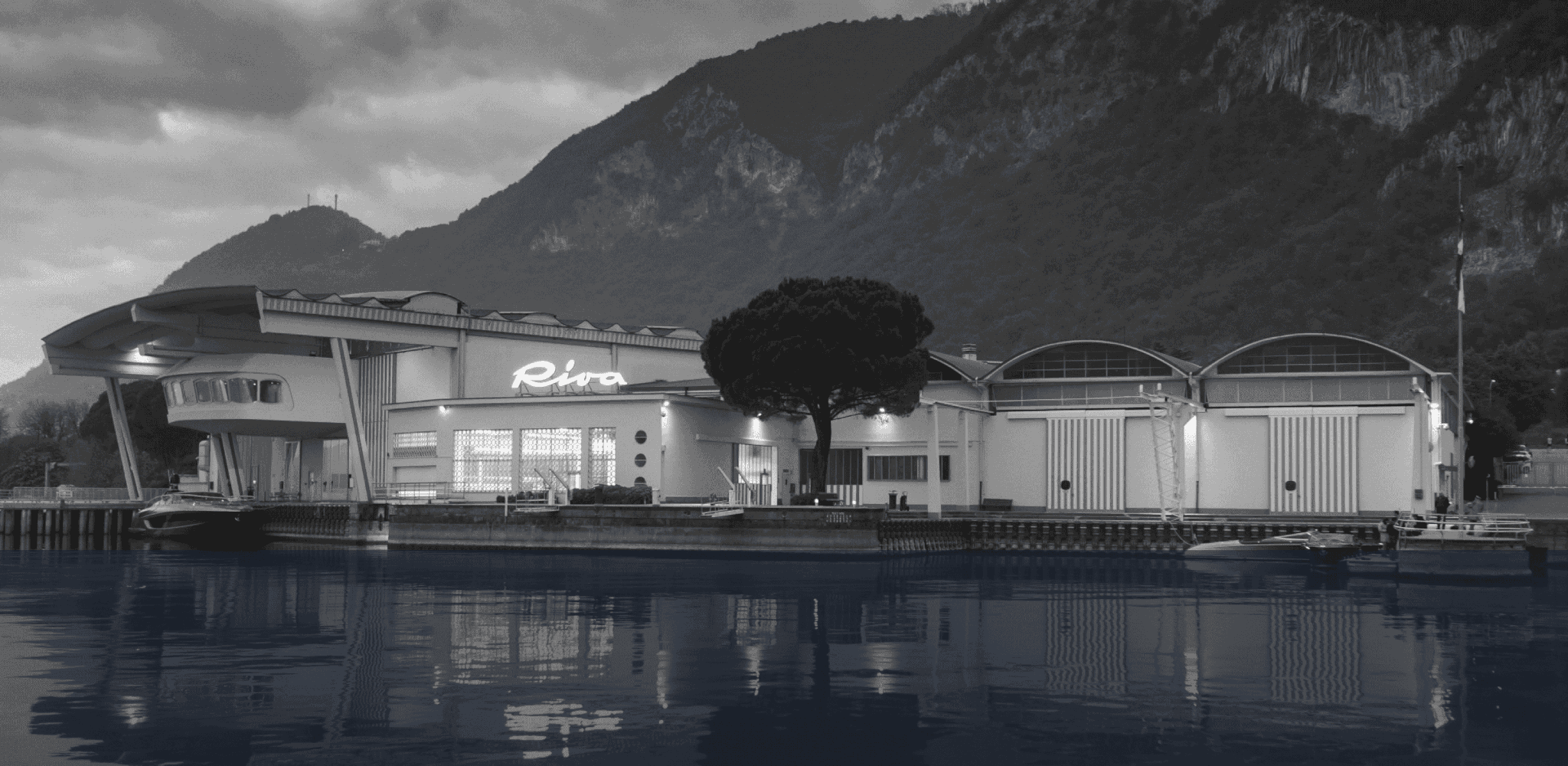
Pioneering timeless design
Riva's 180 th, anniversary.
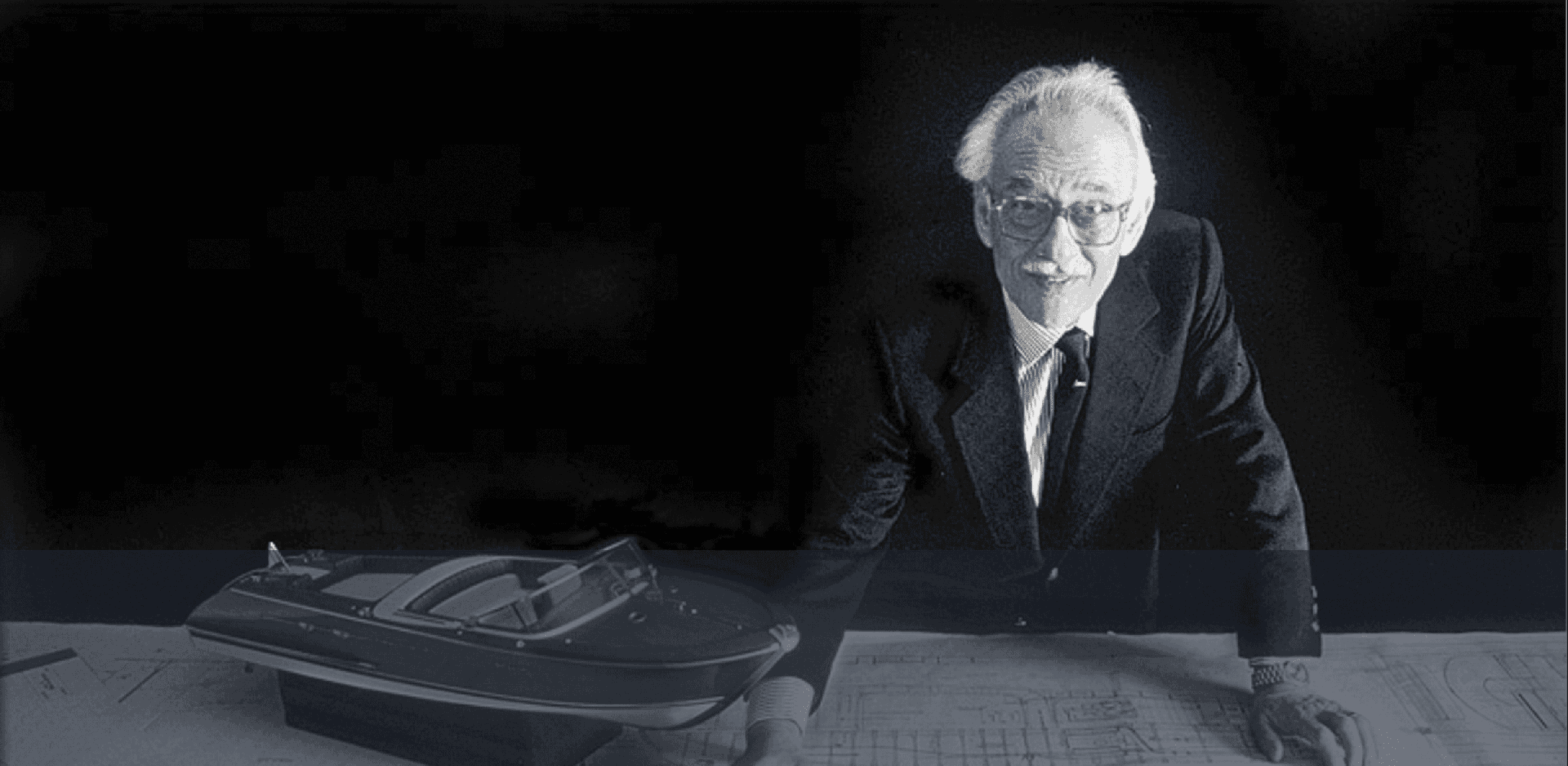
Carlo Riva's
100 th anniversary.
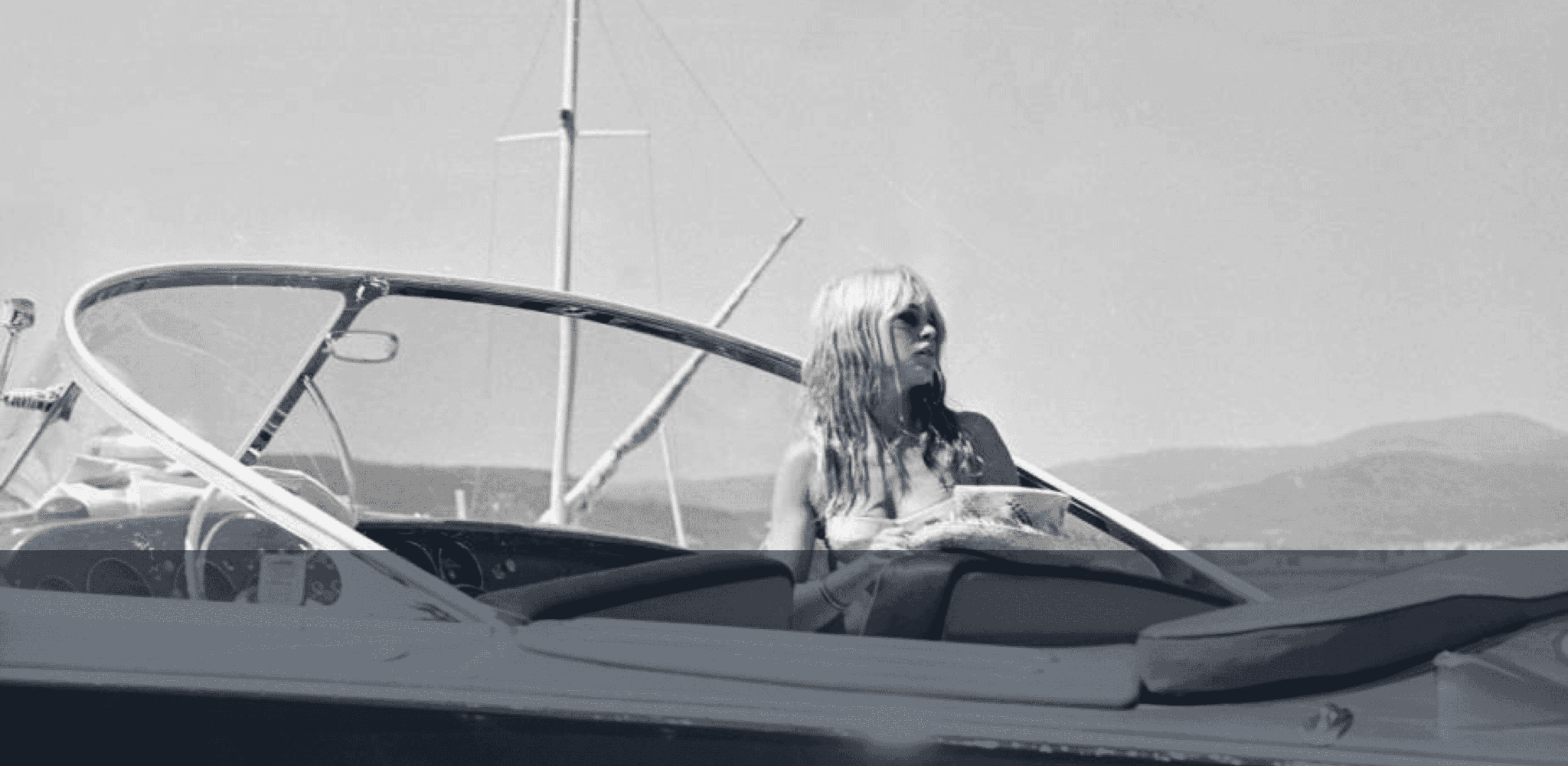
A pairing with legendary appeal
Riva and celebrities.
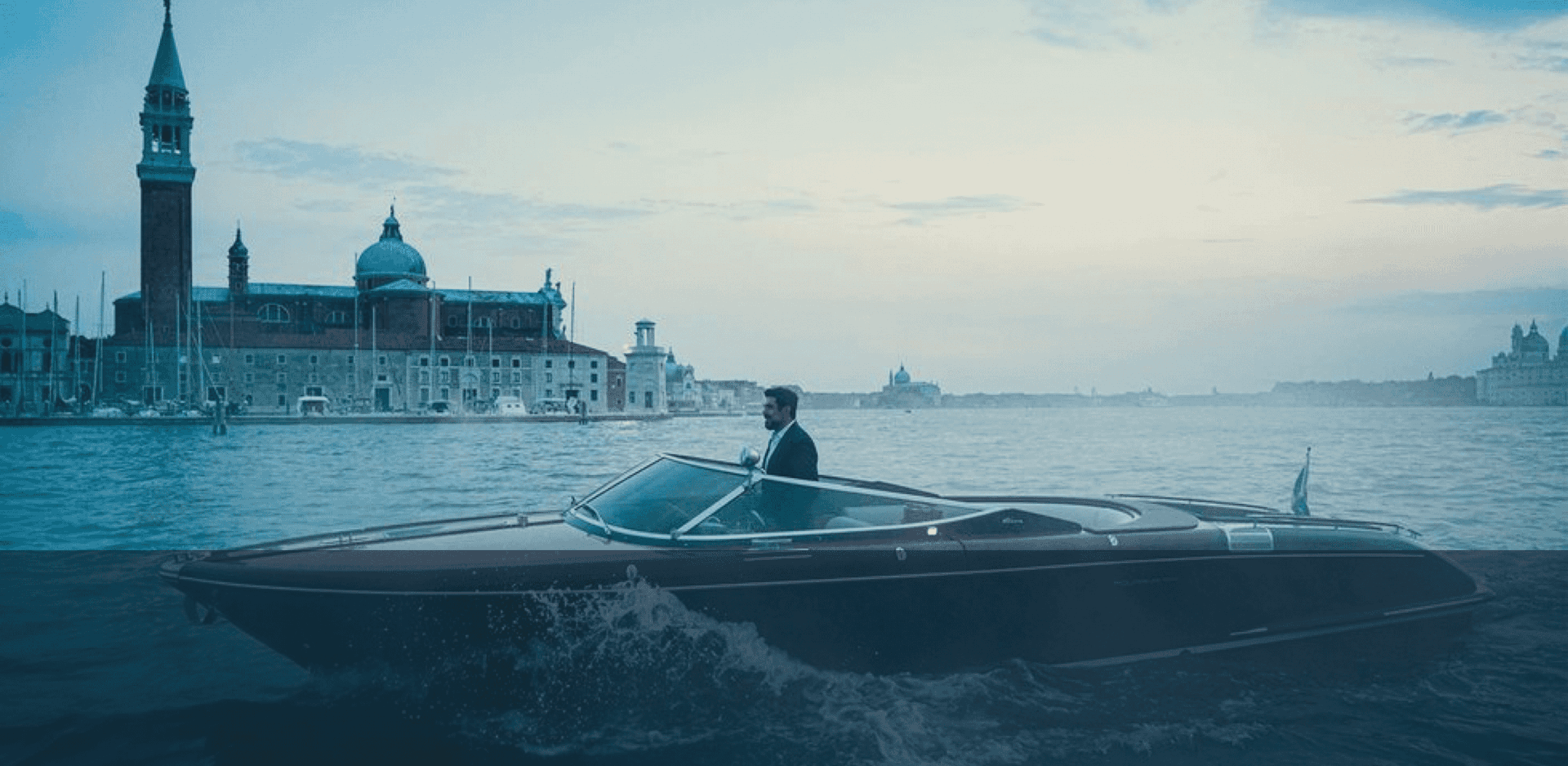
Requited love
Riva and the cinema, the evolution of a legend.
From its origins on Lake Como with Pietro Riva, to the era of the ‘Bella Vita’ and industrial development, through to the present day, in a fascinating journey through history and images of moments that have made history.
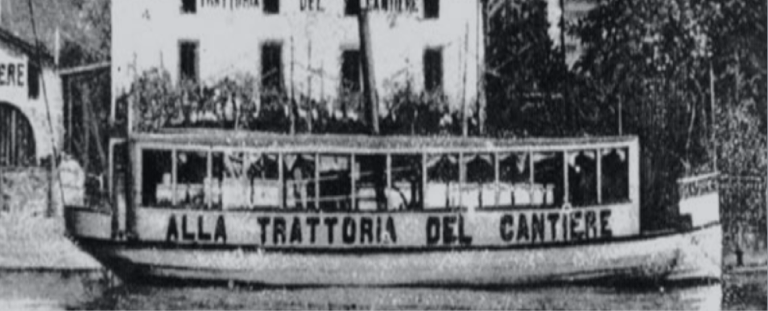
1842 - 1930s

1930s - '40s
The age of racing
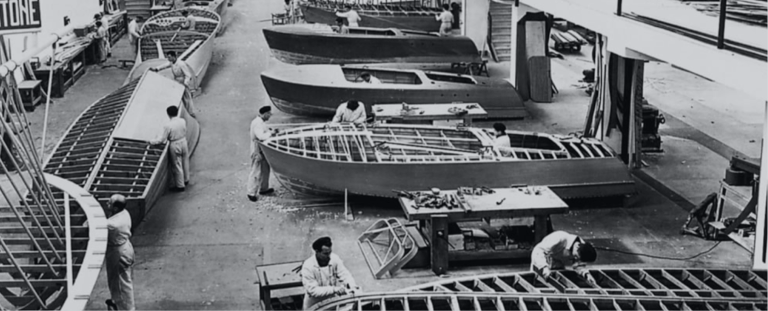
1950s - '60s
Series-produced boats
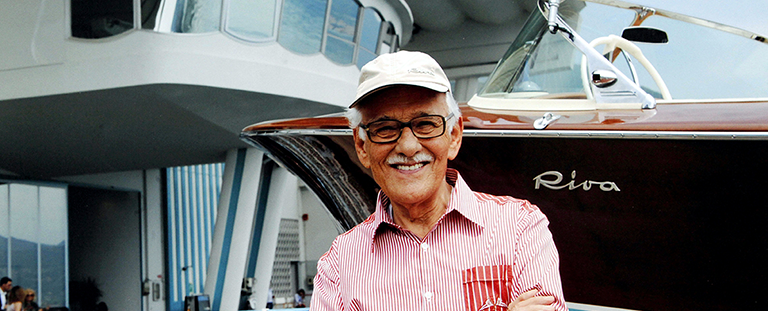
1940s - '70s
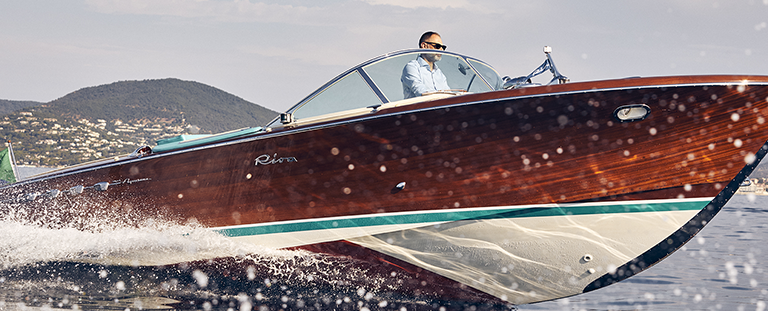
1960s - '70s
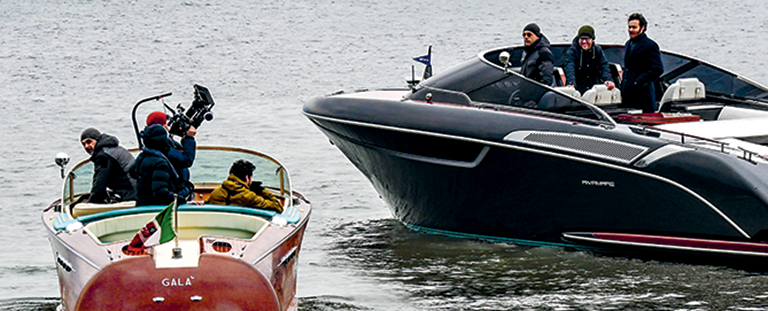
1950s - Today
Celebrities and Filmography
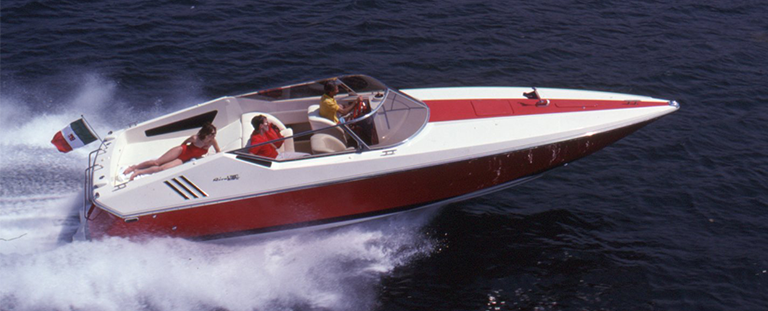
1970s -'99
The era of fibreglass boats
Riva’s 180th anniversary
The timeless workshop where it was all created: the legendary Sarnico boat yard celebrates 180 years since its construction in 1842.

Riva boutique
The quality and unmistakable style of the Riva brand in a collection of unique and original pieces. Take the legend home with you.
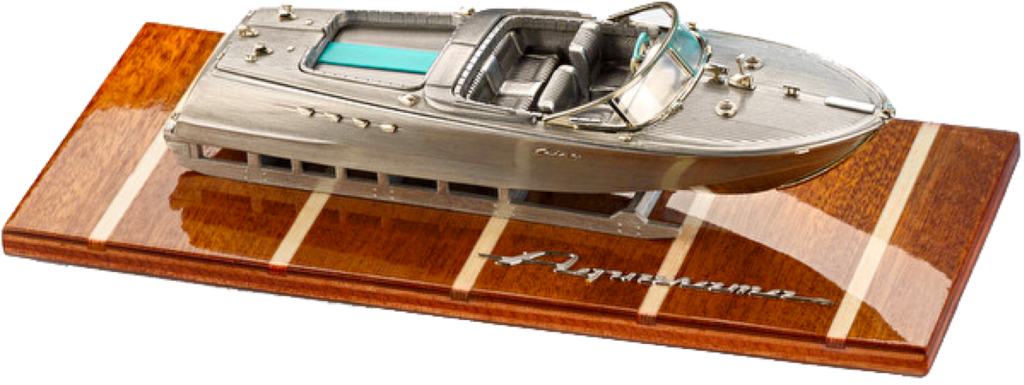
Ferretti S.p.A.
Tax code and VAT no. 04485970968 Registered Office Via Irma Bandiera, 62 – 47841 Cattolica (RN) Italy REA no. RN 296608 - Companies Register no. 04485970968 Share capital € 338.482.654,00 fully paid-up PEC: [email protected]
Riva's Early Years - More Than 170 Years of History
Jul 15, 2021

RIVA'S EARLY YEARS
More than 170 years ago, the Riva family of woodworking craftsmen began building what are now iconic, classically designed boats. The legacy continues today as the line has grown from elegant wooden vessels to a diverse line of luxury fiberglass pleasure boats and yachts.
The Riva Yachts history began in 1842 when Pietro Riva, a 20-year-old carpenter, left Sarnico, Italy to repair boats at Lake Iseo. His exceptional woodworking skills on a severely damaged boat led to additional work in the region to repair and build new boats .

As he completed orders for fishing and row boats, his business and his family grew. He and his wife, Lucrezia Taroni, had five children: Angelo, Francesco, Ernesto, Erminia and Luigi. The middle child, Ernesto, grew up to learn his father’s trade and join him as a skilled carpenter.
With great foresight, Ernesto believed that future boaters would want bigger boats equipped with engines. To meet that vision, he developed and manufactured larger vessels, and as his hunch proved correct, he built his first motorboat.
Success for the father and son’s expanding business soon necessitated they build a new boatyard. Expansion continued as Ernesto built his own boat, named Sarnico in honor of the family heritage and began the first motorized tourist boat trips on Lake Iseo.
The future of the family business was again secured when Ernesto Riva married Carolina Malighetti and the couple had six children: Francesco, Angelo, Serafino, Mauro, Anna, and Pierina. Middle son Serafino took over the business when Ernesto Riva died in a shipyard accident during a large boat launch in 1907. With a new member of the Riva family at the helm, the company focus again veered - this time from transportation to recreational boats as the availability of small inboard and outboard engines increased.
RACING WITH RIVA - LEISURE AND SPEED RAMP UP IN THE 1920s

When the nautical industry saw a sales boom, Serafino Riva capitalized on public interest by building racing motorboats. Serafino raced his Rivas, and early in the fairly new sport, he exceeded 24 km/h in an outboard speedboat in the Spring of 1912. Riva racing boats continued to be top competitors throughout the 1920s and prominent exposure during events helped to expand the leisure-craft market worldwide.
The family line was destined to continue, at least by marriage, when Serafino married Irma Bocchi and had three children: Carlo, Dafne (who married Gino Gervason who eventually joins Riva), and Marilena.
RACING IN THE 1930s AND 40s WITH RIVA

The Riva name continued to capture headlines during the 1920s and 30s. Prominent in the media were famous friends and competitors, Serafino Riva and Giuseppe Guerini. Each raced in Riva boats with the same outboard engines. Riva boats continued to be popular in the racing sport until political events leading up to World War II caused racing to be suspended in Italy.
During the war, production slowed but never ceased at the Riva facility. Many famous racers competed in Rivas including:
- Dino Sestini
- Carlo Pagliano, who set an endurance record in 1938 of more than four hours in an outboard Riva boat with a 250cc engine, with an average speed of 58.54 km/h
- Speedboat racer Count Metello Rossi di Montelera ran Ronzino to win as an Italian champion in 1935 with a 1500cc engine
- Serafino Riva won the Pavia-Venice in a Riva boat


SIGN UP FOR EMAIL UPDATES

- RIVIERA YACHTS
- BELIZE YACHTS
- DESIGN AND BUILD
- YACHT MANAGEMENT
- SUPERYACHT PROJECTS
- PRE-OWNED YACHTS
- NEWS & PR
- LEE MARINE TEAM
- COMPANY NEWSLETTERS
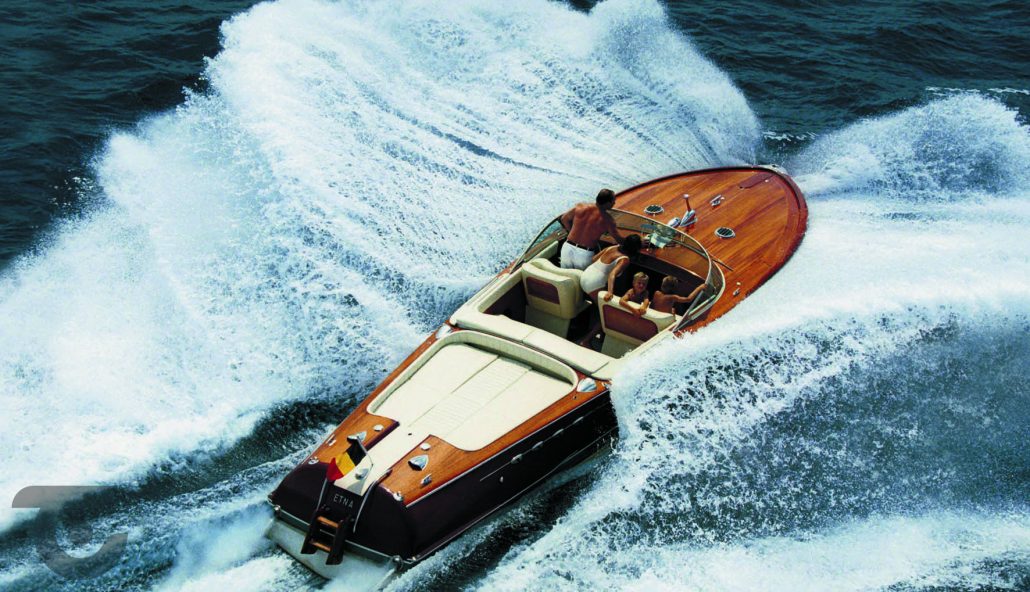
A closer look at the history of Riva
Riva is one of the most famous yachting brands in the world, best known for its iconic series, such as the 100′ Corsaro and the 110′ Dolcevita that capture the Italian style of yachting the good life goes hand in hand with. However, in spite of Riva’s success not many people know the history behind this iconic shipyard – even though the Italian brand has been building ships for more than 170 years. Here we take a closer look at how the company came to be one of the most recognised brands in the industry today.

Riva was founded back in 1842 on Lake Iseo, in Sarnico-Italy following a sudden storm. Local fishermen were shocked when they saw the damage caused to their fleet and banded together to convince a young shipbuilder to repair their vessels. The craftsman, who had recently moved to the region from Laglio, was none other than Pietro Riva. After winning the trust and respect of the locals once he fixed their boats, he began his shipyard, Riva. The first boats made by Riva were launched in the region on the lake and the shipyard rapidly established a reputation thanks to its stylish and high-quality boats. The shipyard continued to flourish under the guidance of Ernesto Riva, Pietro’s son, who introduced internal combustion engines on Riva boats, paving the way for passenger boats and large cargo to cruise the lake.

However, it was not until after World War I that Riva became the brand we know today, when Serafino Riva, Ernesto Riva’s third-born son, began imprinting Riva products. This marked a turning point in the shipyard’s history, as Riva also started moving away from the production of transportation vessels to power boating. Serafino Riva focused on building motor power boats, promoting leisure crafts at speedboat races. Riva went on to make a number of racing yachts between the 1920s and 1930s, which set a number of records in both international and national competitions, capturing the attention of the entire boating industry.

Later on in the 1950s, Carlo Riva, son of Serafino Riva, elevated the shipyard’s reputation even further by only using materials of the highest quality for its vessels, taking care of the smallest detail and focusing on Riva’s expertise and craftsmanship. Riva’s vessels quickly became objects of luxury and desire for the successful and wealthy and the shipyard started working with designer and architect Giorgio Barilani in 1956. Carlo Riva also foresaw the importance of speed and agility in the industry, driven by the Italian industrial revolution, and created a series of wooden yachts which were characterised by one-of-a-kind design features. These included the Ariston, the Tritone (the first two-engine yacht), the Sebino (which marked the beginning of series production), and the Florida.

Awarded the prestigious Pioneer of Boating award by Ucina two times, Carlo Riva has been praised by many for inventing, developing, drawing and creating Italian Style motorboats. Throughout the 1950s Riva became widely known for the elegance of form, excellent safety features and mahogany racing boats. But, it was in November 1962 that the real legend behind Riva was born: the Aquarama. Presented at the third International Nautical Fair in Milan, the yacht quickly became a symbol of Riva’s excellence. The name of the vessel was inspired by the Cinerama system, the American experimental wide screens and its slogan featured keywords like: “Sun, sea, joie de vivre!” Aquarama’s prototype was the Lipicar no.1, the successor to the Tritone, measuring 8.02 metres in length and 2.62 metres wide, powered by twin 185 hp Chris-Craft engines, with a speed of 73 km/h.

Five years later in 1969, Riva hit another milestone – the start of its fibreglass production. Riva unveiled its first two models crafted from composite material, the day cruiser Bahia Mar 20’ and the cabin cruiser Sport Fisherman 25’. Both models feature wooden details, in line with the brand’s traditional style. However, in spite of the success of its fibreglass models, Riva’s production of wooden runabouts continues until 1996, which is when the last Aquarama Special, hull 784, was built. In September of the same year, 1969, Carlo Riva sold the shipyard to an American company, Whittaker, but maintained the role of Chairman and General Manager, until his resignation in 1971. These roles were then taken on by his partner, Gino Gervasoni.

In 1989, twenty years later, English Group Vickers purchased 100% of the shares of Riva and one year later Gino Gervasoni left the shipyard after 41 years, marking the end of the Riva family presence within the Italian company. Nevertheless, the shipyard continues to maintain the values ingrained into the company by the founding family to this day.
In 1991 Riva showcased the 58’ Bahamas at Genoa International Boat Show, the first yacht designed by Mauro Micheli. Nine years later Riva returned to its Italian roots when the Ferretti Group acquired the shipyard on May 1, 2000, from British finance firm Stellican-Investment Bank. Norberto Ferretti took charge of the company and developed a plan to relaunch both the brand as well as its product, focusing on quality, design and style.

Now, more than 175 years since its foundation, Riva continues to flourish, building larger and more extensive superyachts than ever before. The ongoing success of the Italian shipyard is attributed to many factors, in particular, its passion for developing quality, stylish and elegant vessels. A Riva yacht is always instantly recognizable, as the shipyards roots are intertwined with tradition, innovation and love for crafting unique motorboats. Today, the unmistakable fleet Riva includes the flagship series 110’ Dolcevita, 100’ Corsaro, 88’ Florida, 88’ Domino Super, 76’ Perseo, 76’ Bahamas, 66’ Ribelle, 63’ Virtus, 56’ Rivale, Rivamare, Aquariva Super and Iseo.
Content created in collaboration with Riva
Privacy Overview
- THE PRINCESS PASSPORT
- Email Newsletter
- Yacht Walkthroughs
- Destinations
- Electronics
- Boating Safety

Riva’s First Superyacht
- By Diane M. Byrne
- Updated: July 28, 2020
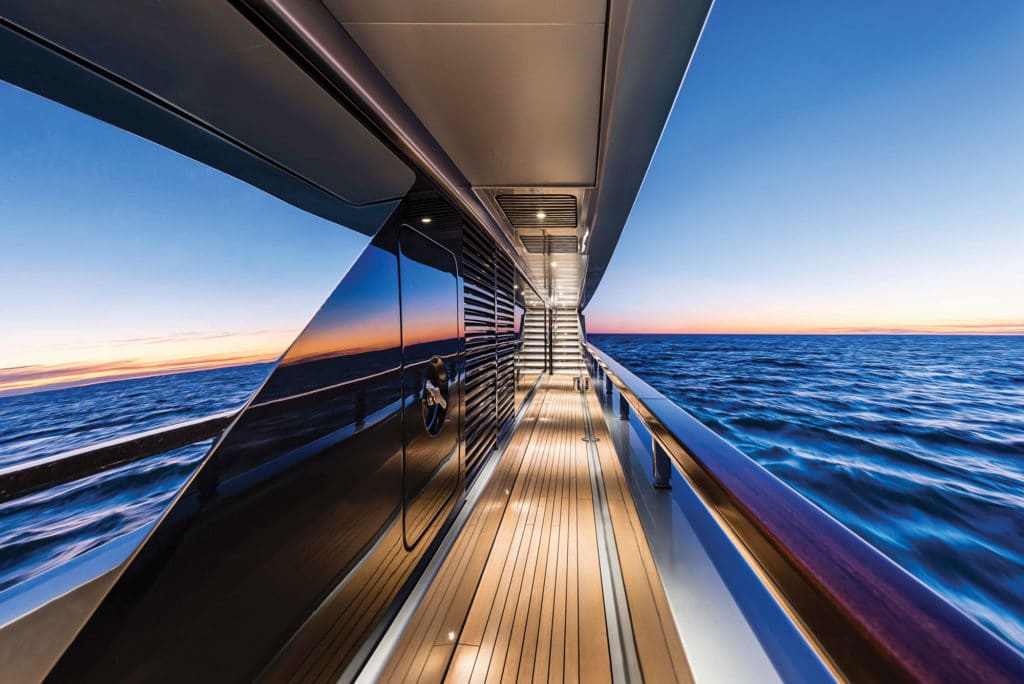
In the early 1950s, a young man enthralled with his father’s boatbuilding company took over the family business. As sometimes happens when new generations step in, he wasn’t content to do the same thing his father, or his grandfather, had done. Strong ambition persuaded him to design and build pleasure boats, as opposed to the racing and commercial boats of the shipyard’s past. What’s more, he continuously wanted to outdo himself, focusing on creating motoryachts that were more than boats, as well as status symbols.
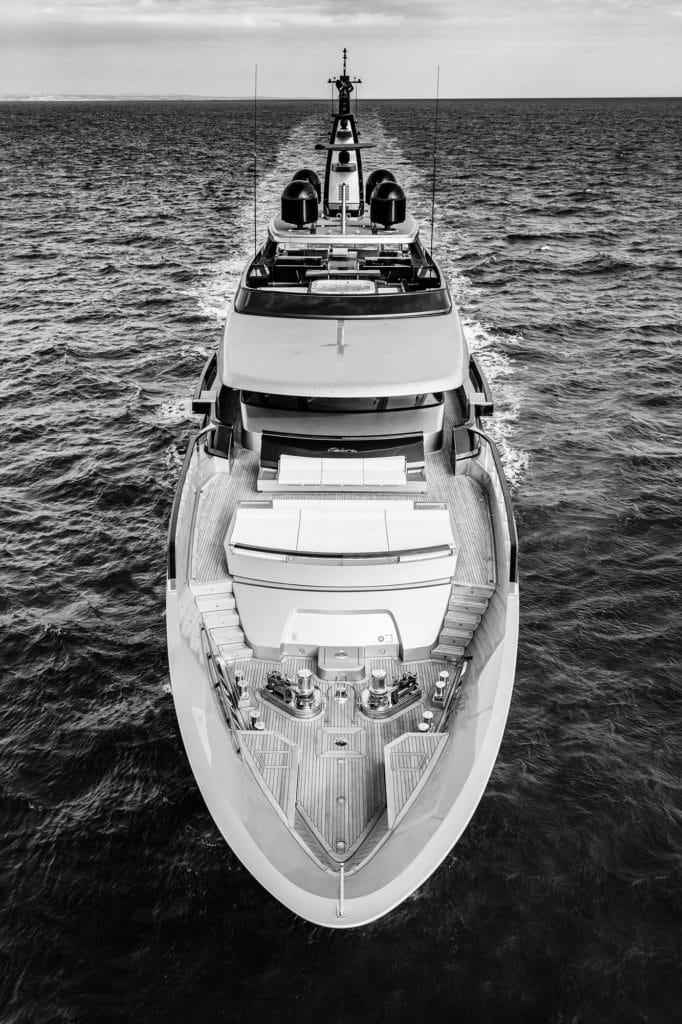
While the young Carlo Riva succeeded in all of this after taking the helm of Riva, there’s perhaps no better example of his driving ambition than the period from the mid-1960s into the 1970s, when he launched three limited series of motoryachts.
Not only were their steel hulls a marked change from the glistening mahogany of their sisterships, they were also far larger. The Atlantic series, at 88 feet, and the Caravelle series, at 74 feet, were astoundingly large for their eras. Between their style and the fact that they were faster than many other yachts at the time, they helped Riva find several clients.
More than 50 years later, the spirit of these series lives on with the Riva 50-Meter. It’s the first model in the Riva Superyachts Division and the second Riva constructed entirely of aluminum. At 160 feet, 9 inches length overall, she’s larger than any previous launch from the boatbuilder, but she upholds many of the same principles her predecessors established.
“She is full of personality, exactly like any other Riva yacht,” says Sergio Beretta, CEO and co-founder of Officina Italiana Design, the studio responsible for every modern-era Riva. “It is essentially a true connoisseur’s boat. In a nutshell, it is chic, and that is the whole logic behind it.”
Mauro Micheli, chief designer and co-founder of Officina Italiana Design, agrees. “It is certainly a boat with a very different character to its siblings” because of the LOA and four decks, he explains, “but references to Riva’s signature styling are a constant.”
That styling is well-known and detailed. For instance, Hull No. 1, Race, shows off varnished mahogany and stainless-steel handrails, complementing the metallic painted surfaces. Even the yacht’s wing stations have these handrail details. The richness of the high-gloss wood serves as a reminder that “artisanal craftsmanship is at the very core of each project,” Micheli asserts. “The handrails are the fil rouge [French for common thread] of the yacht.”
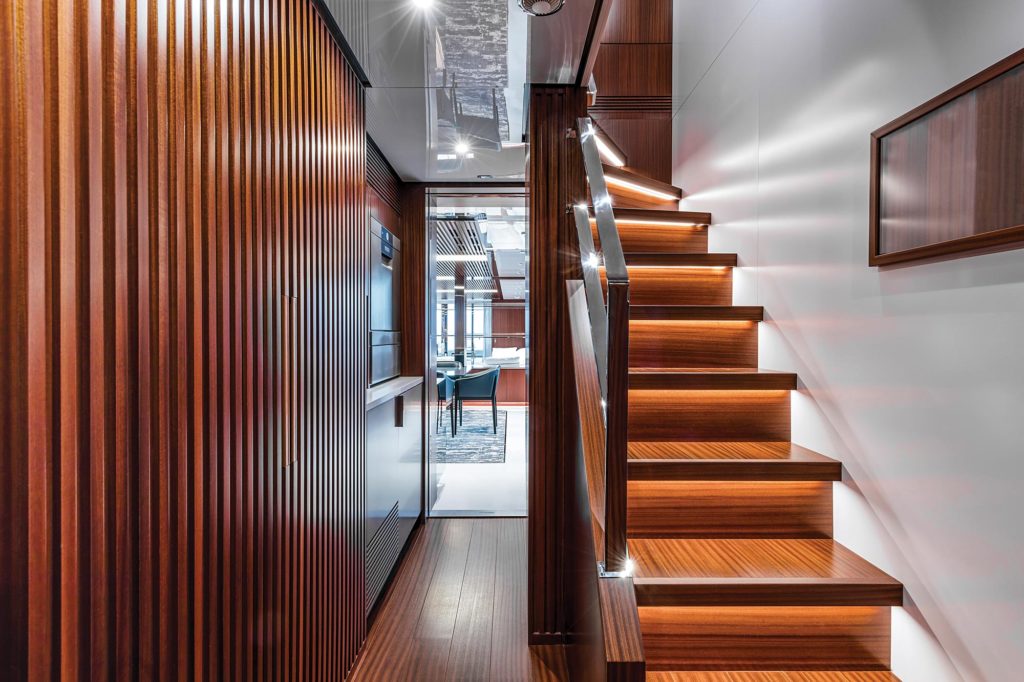
Further to the styling’s influences, Micheli mentions the Caravelle line, conceived in 1964. Its uncluttered, simple elegance inspired the team working on the 50-Meter. Though more angular than today’s yachts, the Caravelle had long lines and a proud bow—two timeless characteristics.
“They are the kind of lines that don’t necessarily set out to dazzle but still capture attention with their sheer simplicity,” Micheli says.
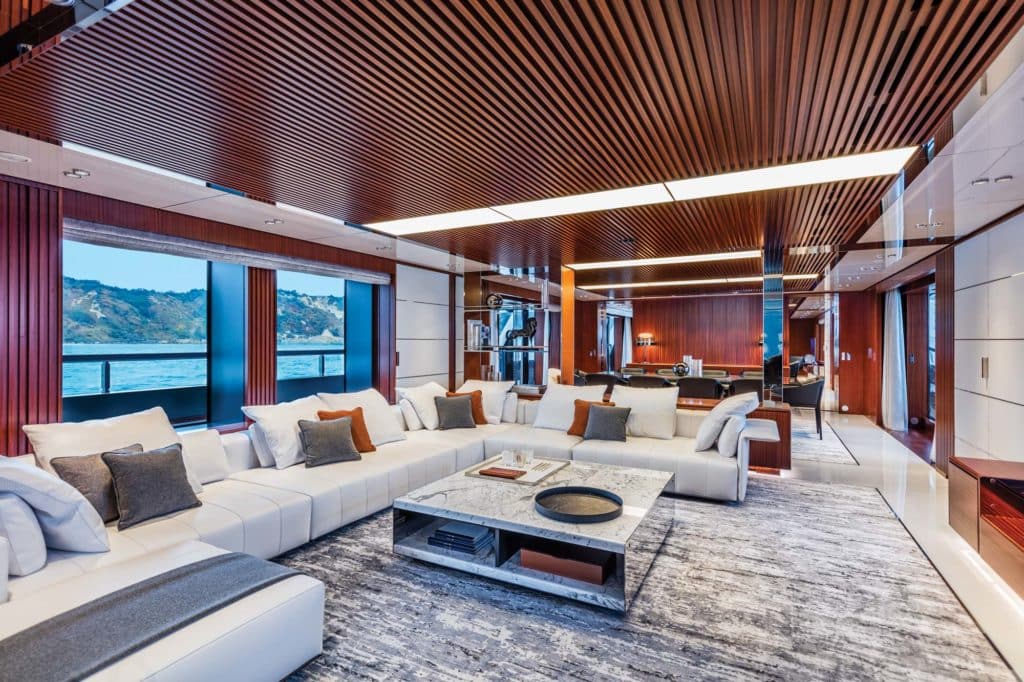
For the Riva 50-Meter, the studio focused on classic yet sleek lines. “Race has a great personality,” he says. “She has three straight lines that define each level. The design is clean. We refuse overworked, elaborate and redundant lines.”
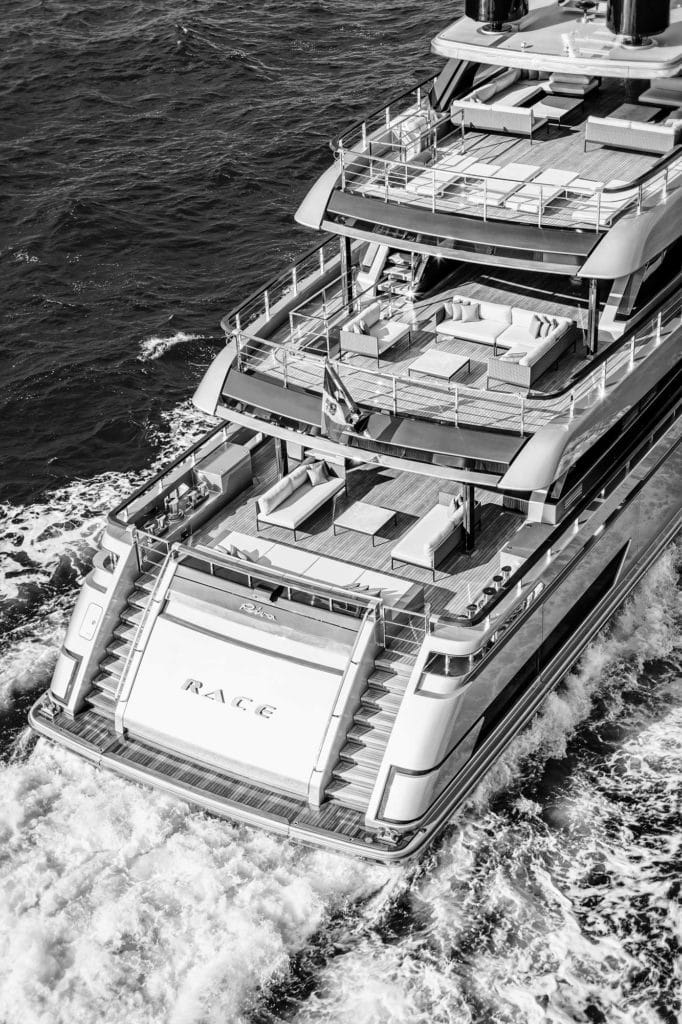
Amid these lines are some of the owner’s particular requests. “He wanted lots of light and to enjoy the external panoramas,” Micheli says. While every Riva—indeed, every large yacht—these days incorporates large glass ports, Race’s owner felt it was especially important for the 50-Meter to have them, notably along the main and upper decks. Additionally, in an interesting twist on an indoor-outdoor area, the covered alfresco dining area aft on the upper deck has slide-open glass to each side.
In terms of the open alfresco areas, meanwhile, the owner wanted a front-row seat for when he was approaching shorelines. This explains why Race has cozy seating and viewing spots at the bow and up on the sun deck. Yet another request outside, for similar reasons: a walk-around hot tub and sun pads aft on the upper deck. The owner envisioned standing back here as Race entered a marina and tied up stern-to.
Inside is a relatively customary arrangement, with accommodations for 10 to 12 guests in five staterooms: a main-deck master and four guest staterooms below. However, the owner did request that the galley go belowdecks, with a dumbwaiter connecting it to each of the upper levels. The relocation of the galley permitted more room for the master stateroom.
With Hull No. 2 in the 50-Meter series under construction, Riva is poised to make its mark in the superyacht sector. Larger models are coming too, with the biggest being the 90-Meter (295 feet).
And while Carlo Riva didn’t live to see the 50-Meter launch, having died at age 95 in 2017, there’s no doubt he’d be proud. “The first time that engineer Carlo Riva saw the renderings of the first Riva 50-Meter mega-yacht, he said, ‘I’d like to try and cruise on her,’” Micheli recalls.
Perhaps the once-determined heir to the family business is doing that in spirit.
Take the next step: riva-yacht.com
- More: Megayachts , Reviewed , Riva , Riva Yachts , Superyachts , Yacht Reviews , Yachts
- More Yachts
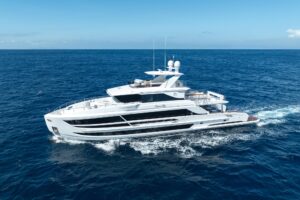
Horizon Yachts Unveils FD108 Tri-Deck
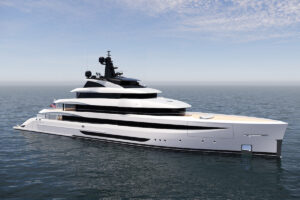
CRN to Build 220-Foot Superyacht
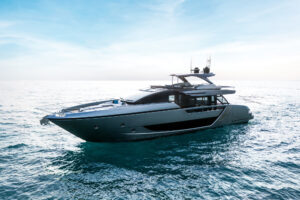
Riva 82′ Diva Reviewed
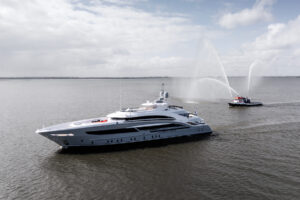
Heesen Yachts Delivers 164-foot “Cinderella Noel IV”
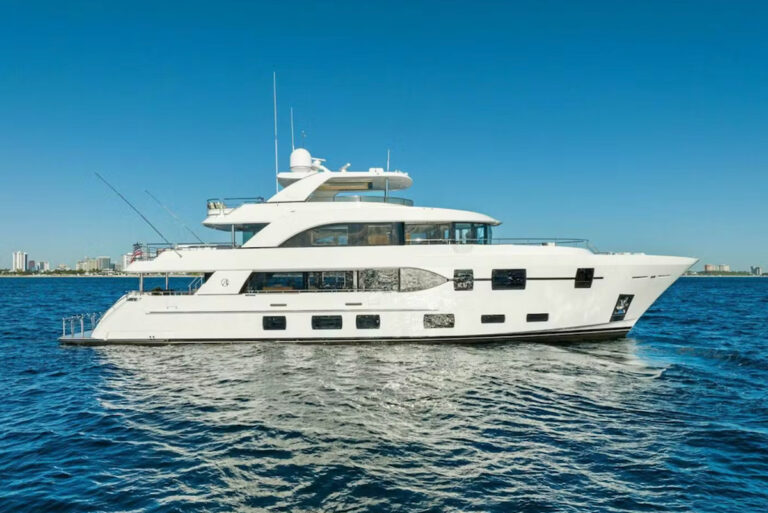
For Sale: 2017 120′ Ocean Alexander
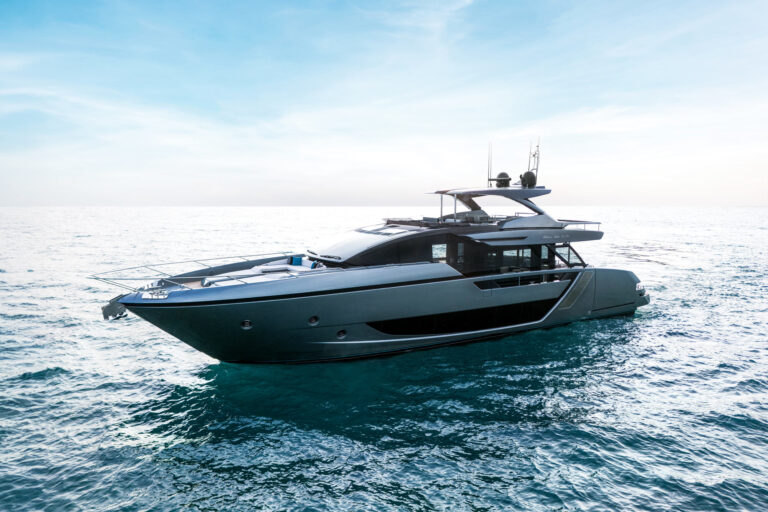
For Sale: Aquila 54 Power Catamaran

- Digital Edition
- Customer Service
- Privacy Policy
- Email Newsletters
- Cruising World
- Sailing World
- Salt Water Sportsman
- Sport Fishing
- Wakeboarding
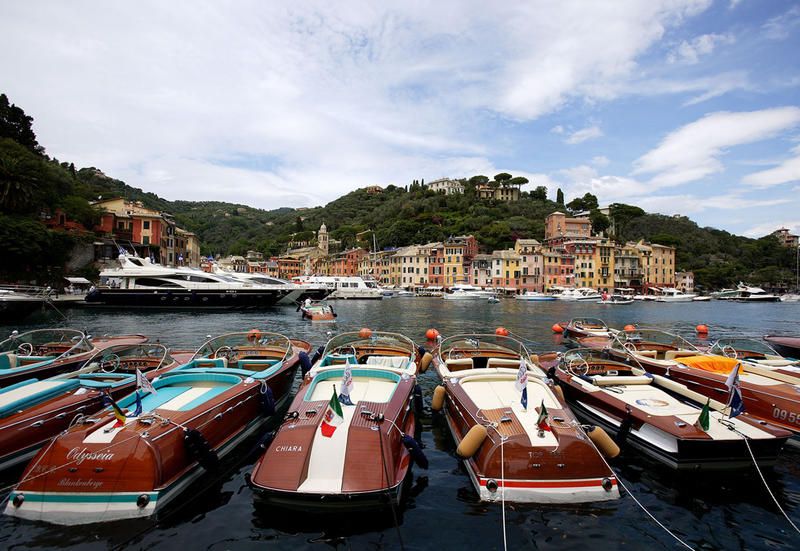
Breve storia dei motoscafi Riva: dal battello da pesca ad Anita Ekberg
La storia del mitico cantiere che ha realizzato motoscafi immortali espressione del Made in Italy
Lo storico cantiere di motoscafi Riva è tra i più rappresentativi dell'eccellenza del Made in Italy in campo nautico. Nato da un'avventura imprenditoriale che ha origine nel 1852 a Sarnico (foto sotto) , sulla sponda occidentale del Lago d'Iseo, ad opera del maestro d'ascia Pietro Riva che ha fondato questa dinastia di costruttori di barche , è oggi un vero e proprio mito della nautica italiana . Perché Riva è molto di più di un costruttore: ha regalato sogni ad intere generazioni.
Qual è l'elemento che sta alla base del mito? Sicuramente la passione e la cultura del modo di fare le barche che Riva ha nella propria storia e nella propria realtà attuale. Il cantiere, in origine, si occupava della riparazione e della costruzione d'imbarcazioni da lavoro ("batel de pesca") e da diporto ("canotto da passeggio") tipiche della zona. Il figlio di Pietro, Ernesto, intuirà che il motore sarà il futuro della nautica da diporto e inizia a costruire barche di dimensioni sempre più grandi. Il suo primo battello a vapore - con cui proponeva le prime escursioni turistiche sul lago - si chiamerà Sarnico, in onore del paese d’origine.

Finita la Grande Guerra è Serafino Riva che orienta il cantiere alla produzione di scafi performanti in legno per competizioni motonautiche, all’epoca agli albori: le sue barche riusciranno a vincere prestigiosi trofei (foto sotto) . Negli anni Quaranta Serafino è affiancato dal giovane figlio Carlo - futuro pioniere della nautica da diporto a motore, appena scomparso - che però si discosta dalla filosofia progettuale paterna. Egli, animato da una passione sconfinata per le barche e il lavoro del cantiere, ha le idee ben chiare: soltanto una produzione seriale e altamente qualificata potrà permettergli di realizzare il suo sogno, ovvero quello di far del nome Riva - come a suo tempo era riuscito agli americani di Chris-Craft - sinonimo di yacht di lusso , inventando, rinnovando, ingrandendo anche a costo di rischiare tutto.
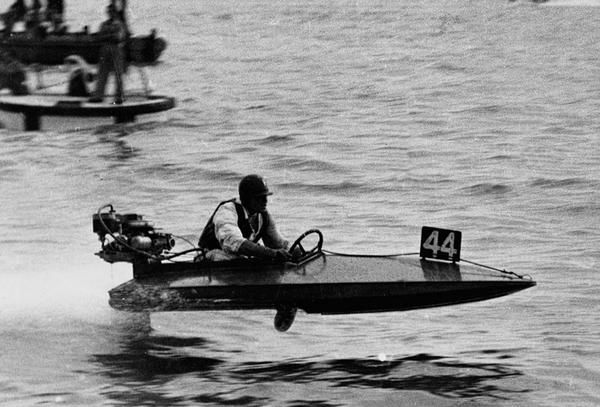
Negli anni Cinquanta, Carlo Riva sbarca negli Stati Uniti e conclude la prima importazione di motori americani risolvendo il problema più grave dei suoi scafi. Da quel momento gli eleganti motoscafi in legno Riva non avranno più concorrenti e saranno oggetti del desiderio di famiglie reali, di celebrità del cinema, di campioni dello sport, di uomini d'affari e dello smart-set internazionale che riempiva ogni settimana le pagine dei rotocalchi. Chi sceglieva la Rolls-Royce o la Ferrari su strada, sceglieva Riva sull'acqua, senza incertezze.
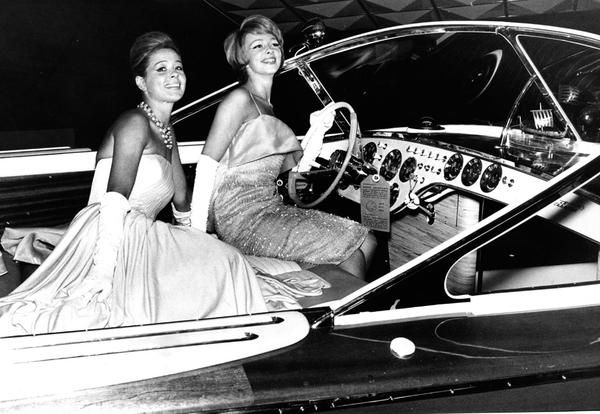
Nel pieno boom economico italiano l’Ingegnere Carlo Riva dà vita ad una serie di barche in legno eleganti e raffinate, dallo stile inconfondibile, vere e proprie opere d'arte in cui viene coniugata l'eccellenza costruttiva con la cura maniacale dei dettagli; motoscafi di lusso che da mitici diverranno ben presto leggendari. Tra questi di sicuro spicca l’ Ariston (foto sotto) , di cui Carlo diceva: "Disegnato con amore, nato forte e puro come un cavallo di razza. Indimenticabile! Il mio signore del mare". Seguiranno il Tritone - motoscafo di cui Anita Ekberg, la diva svedese della Dolce Vita, si innamorò tanto da volerne uno personalizzato con tappezzeria zebrata (foto sotto) - che rappresentò un passo avanti ingegneristico importantissimo (è, infatti, il primo bimotore di Riva); il Sebino , che inaugura la produzione in serie e il Florida , che nel nome richiama il modello americano particolarmente in voga in quegli anni. Dal 1956 inizia la collaborazione con l'architetto e designer Giorgio Barilani, la cui attività progettuale diventa esclusiva per Riva.
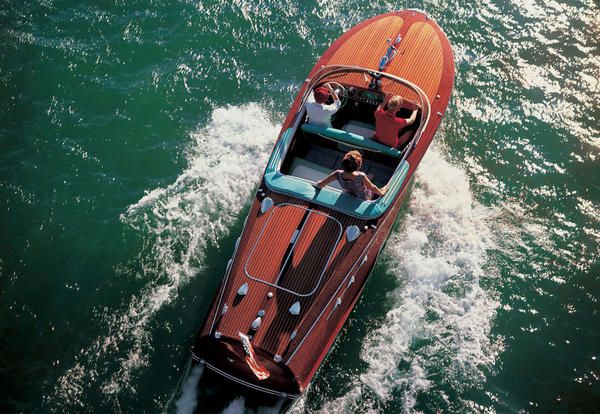
Il mito della produzione Riva nasce nel novembre del 1962, quando l’ Aquarama viene presentato al Terzo Salone Internazionale della Nautica a Milano con lo slogan "Sole, mare, gioia di vivere" e diventa da subito il sogno di tutti gli appassionati. Possedere un Aquarama significava non soltanto avere un oggetto tecnologicamente avanzato e pregiato, ma far parte di un mondo contraddistinto da stile, lusso e mondanità. L’Aquarama diventa l'icona Riva, il simbolo, un marchio nel marchio, un desiderio che si materializzava con ben 10 milioni ed 800 mila delle vecchie lire.

Nel settembre 1969 Carlo Riva, amareggiato dai continui scioperi degli operai, decide di vendere il cantiere alla statunitense Whittaker, pur mantenendo sempre le cariche di presidente e direttore generale. Acquisito nuovamente dal gruppo inglese Vickers, di cui faceva parte anche il brand Rolls-Royce, nel 2000 il cantiere entra a far parte del Gruppo Ferretti . Da qui per Riva inizia una nuova, fresca e grintosa epoca anche grazie allo straordinario talento del designer bergamasco Mauro Micheli , fondatore insieme a Sergio Beretta di Officina Italiana Design, lo studio che disegna in esclusiva l'intera gamma di lusso. Lo yacht designer, considerato un Maestro della nautica italiana a motore dei nostri giorni, riesce ogni volta a interpretarela tradizione Riva declinandola con linee contemporanee. Dall' Aquariva del 2001, allo SportRiva del 2007, al Rivamare (foto sotto) dello scorso anno fino al recente Riva 56' Rivale (foto sotto) appena presentato, Micheli ha contribuito a rafforzare l'idea di sobria eleganza e perfezione che hanno sempre contraddistinto il cantiere lombardo, progettando barche dall'estetica essenziale, coerente e rigorosa che danno allo stesso tempo l'idea di velocità e comodità capaci di sedurre e conquistare l'osservatore. Riva porta con sé, infatti, da 175 anni qualcosa di magico che affascina, incanta e dolcemente propone il pieno riconoscimento di un carattere, di uno stile, di una personalità.
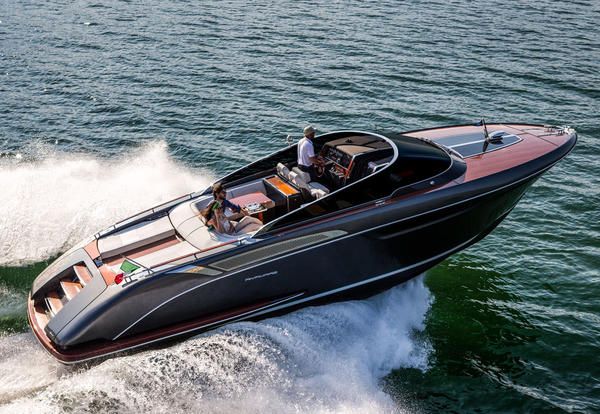
In apertura: I LUSSUOSI MOTOSCAFI RIVA, ICONE DELLA DOLCE VITA

Speciale Barche
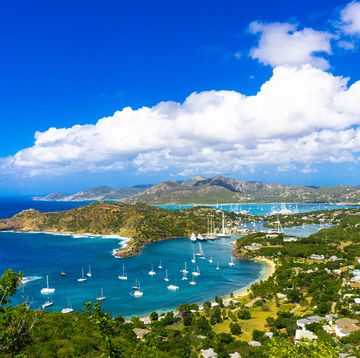
La nuova Luna Rossa è pronta per l’America’s Cup
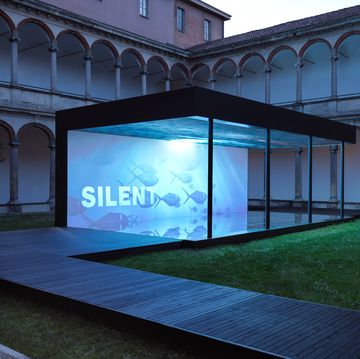
L’installazione SUB: il mare visto dal mare
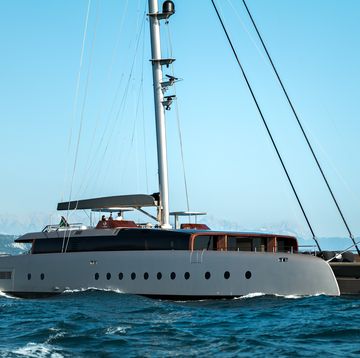
Perché Art Explorer è la prima barca-museo
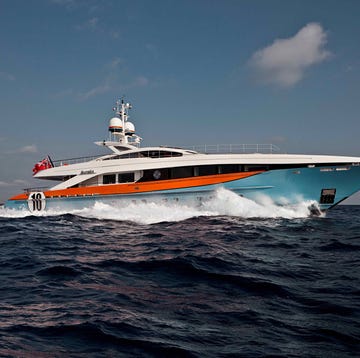
Aurelia, la numero 10 dei mari
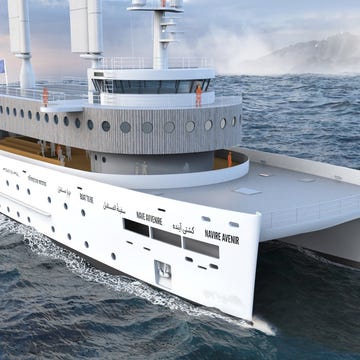
Navire Avenir, a Floating Hospital
Il catamarano per il salvataggio in alto mare

Lo yacht dell’ultima vacanza di Lady Diana
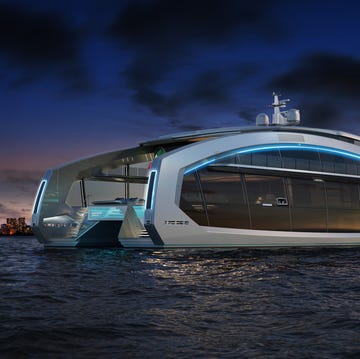
10 yacht extra lusso del Monaco Yacht Show 2023
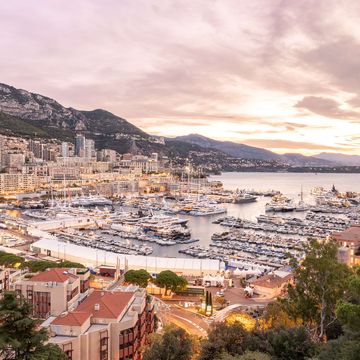
La nautica extra lusso in scena a Monaco
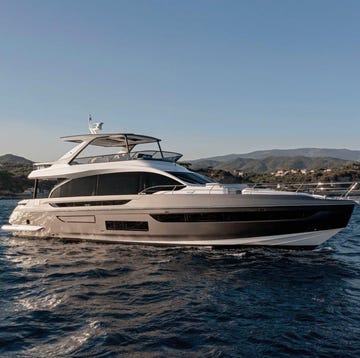
10 barche imperdibili del Salone Nautico di Genova
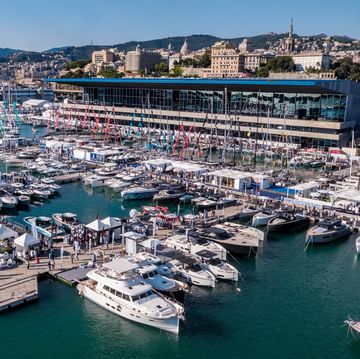
Al via il 63° Salone Nautico di Genova

The global authority in superyachting
- NEWSLETTERS
- Yachts Home
- The Superyacht Directory
- Yacht Reports
- Brokerage News
- The largest yachts in the world
- The Register
- Yacht Advice
- Yacht Design
- 12m to 24m yachts
- Monaco Yacht Show
- Builder Directory
- Designer Directory
- Interior Design Directory
- Naval Architect Directory
- Yachts for sale home
- Motor yachts
- Sailing yachts
- Explorer yachts
- Classic yachts
- Sale Broker Directory
- Charter Home
- Yachts for Charter
- Charter Destinations
- Charter Broker Directory
- Destinations Home
- Mediterranean
- South Pacific
- Rest of the World
- Boat Life Home
- Owners' Experiences
- Interiors Suppliers
- Owners' Club
- Captains' Club
- BOAT Showcase
- Boat Presents
- Events Home
- World Superyacht Awards
- Superyacht Design Festival
- Design and Innovation Awards
- Young Designer of the Year Award
- Artistry and Craft Awards
- Explorer Yachts Summit
- Ocean Talks
- The Ocean Awards
- BOAT Connect
- Between the bays
- Golf Invitational
- Boat Pro Home
- Pricing Plan
- Superyacht Insight
- Product Features
- Premium Content
- Testimonials
- Global Order Book
- Tenders & Equipment

Reinventing Iconic: On Board the Riva 110 Dolcevita
Iconic style on a larger scale – Riva brings the feel of its famous runabouts to its 33.5-metre superyacht. Risa Merl learns how...
Since Brigitte Bardot was first spotted on board her Riva Super Florida Nounours off Saint-Tropez in the 1960s, the Riva brand has been synonymous with glamour, speed and classic good looks. It’s a heady combination that has earned the Italian builder a loyal fan base. Vintage Rivas are so legendary, in fact, they are some of the few yachts to increase in value as they age – the last wooden-hulled Aquarama to be built was sold at auction for $975,000 (£763,000) nearly 40 years after its launch.
The question was, as Riva moved into building fibreglass motor yachts in the 2000s, could the style, grace – and success – of a classic Riva ever be replicated on a larger scale? The builder’s latest fibreglass flagship, the 33.5 metre 110' Dolcevita, is specifically designed in the hopes of answering this query with a resounding yes.
“Bringing the iconic Riva styling into a larger boat was the target since the beginning of the project,” says Giordano Pellacani, head of sales and marketing at Riva, under the Ferretti Group umbrella. “If you look at the previous [large] Riva models, they were not exactly in that style.” The Dolcevita is a step up from the 29.9 metre Corsaro model that, while good-looking in its own right, did not carry forward the trademark Riva styling to the same extent that the Dolcevita aims to.
Riva embarked on a thorough review and development process, spending twice as long in the planning phase as they usually would on a project. “We interviewed many customers and found they wanted something that reminded them of smaller Rivas, with attention poured into our classic details – but on a megayacht,” Pellacani says, referring to Riva’s trademark use of mahogany wood, gleaming stainless steel and rich leathers. These features loom large on the Dolcevita, but with a modern twist. The team at Officina Italiana Design – the exclusive designer of Rivas since 1994 – was inspired by classic Rivas but was careful not to create a retro boat. The new Dolcevita had to perfectly balance modern styling with the timeless luxury that clients associate with Riva.
“Riva design centres around clean, spare lines, resulting in elegant boats,” says the CEO of Officina Italiana Design , Sergio Beretta. “The 110' Dolcevita is in the spirit of Riva tradition. The lines are clean and elegant, including throughout the model’s interior, where the style was personalised to suit the owner’s requirements.” With an integrated flybridge and a silver-grey paint job, the 110' Dolcevita has a sporty look. Gaze closer, however, and you’ll notice sinuous exterior lines that are detailed yet well-balanced, providing just enough handsome Riva styling while meeting the design team’s maxim that less is more. The black windows on the main deck form a continuous band, a feature that defines the exterior but is best appreciated from inside, where such glazing allows for 270-degree views.
“The saloon has unusual windows that run for most of the yacht’s profile, creating a sense of visual space and breadth aft because there is no structure,” says Mauro Micheli, chief designer of Officina Italiana. “From an engineering point of view, it was an interesting challenge. The idea was, how can we give something to owners that no one else has in this size range? You might see windows like this on a much larger yacht, like Vava 2 or Musashi . But how could we create this atmosphere on a smaller yacht? When we told the engineers what we wanted, they said, ‘You’re crazy’.”
To conjure up an open feeling reminiscent of a Riva runabout inside a superyacht was no small feat. Riva’s engineers devised a “spider structure” that allowed for huge windows supported by minuscule mullions. Four transversal and four longitudinal pieces of stainless steel combine to make a frame that is attached to the hull, supporting the stress of the yacht and connecting the hull and superstructure. The result is what Pellacani calls “the crystal palace” – a light-filled interior with seamless windows, remarkable indoor-outdoor continuity and panoramic views.
The abundance of glass lets in massive amounts of light to the wood-filled interior, illuminating the high-gloss joinery. “We used a lot of wood, as per Riva tradition, but in this case we went for rosewood,” Micheli says. Rosewood is similar to mahogany, but has darker veining and a dense grain that makes it very durable, and the wood takes a polish well.
For 70 per cent of its boats built these days, Riva uses pre-engineered woods to avoid mistakes, knots or misalignments showing in the veneer. “For Dolcevita, we opted to use real wood and keep the defects in, we wanted to see them, then apply our love of detailing,” Pellacani says. “We use more material this way – because sometimes you need quite a big piece for the furniture – which is reflected in the price point.”
The wood is refined by a team of in-house carpenters, the same craftsmen who work on smaller Rivas. Real wood, in all its natural glory and coated in gleaming varnish, certainly elicits the richness of a classic Riva launch. Deckheads are raised and the ceiling inset with shining rosewood, which gives a warmth to the spacious saloon.
To complement the light-reflecting rosewood, Officina Italiana Design brought in a pale-grey matte finish for the walls, which matches the light grey sofa. The interior has an understated elegance. Classic nautical materials combine with modern furnishings, such as the glass dining room table paired with leather and stainless-steel chairs. “There are a lot of details in leather and stainless steel that is the leitmotif for the interior and exterior,” Micheli says. The Riva branding is signalled in this and in more literal detailing, like the curved silver door handles imprinted with a Riva logo.
Nine Dolcevita hulls have been sold so far, heading off to locations ranging from Asia and the Middle East to Europe and the US. Half of those owners already have a smaller Riva and were looking for something to represent their love of the brand on a bigger scale. Hull five was the first to be seen by the public at the Monaco Yacht Show last September; the first four were delivered quickly and are being enjoyed by their owners. The new offering seems to appeal to both to Riva loyalists and to those looking for interesting amenities in a smaller package.
Feedback from one owner, who was looking for “big boat features but on a smaller scale” inspired Dolcevita’s unusual layout. While nearly every large yacht has the guest passageway to starboard and the crew to port, this Riva has the hallway leading to the full-beam owner’s cabin on the port side.
“We looked at our bigger 40- to 50-metre boats, and one of the things they must have is a dayhead near the main saloon, because owners throw dinner parties and do not want people in the guest cabins,” Pellacani says. “So we decided to have a very large dayhead on the left side of the main deck.” This dayhead is tucked under the port-side superstructure, set in a wide hallway just before the door to the owner’s suite.
Like the saloon, the master cabin is adorned with rosewood, grey soft goods and carpeting, and chocolate-brown leather chairs. Stainless-steel details also decorate the raised ceiling and are used for the wardrobe door handles. A smoked glass wall across from the bed adds depth and conceals a television. This recurrent theme of “Riva details”, reaffirming the yacht’s ties to its heritage, is carried through into the guest cabins as well. Four are found below, with the layout customisable. The owner of hull five opted for three VIPs and one cabin with twins and a Pullman berth. The rosewood details are even seen in the guest bathrooms.
Exterior spaces aim to recreate the feeling of flying jauntily around the harbour on a much smaller Riva. One such space is the foredeck lounge, accessed via a stairway leading forward from the starboard side. This sunpad-laden spot encapsulates the feeling of sprawling out on the back of an Aquarama, but with even more comfort. The foredeck lounge can also be customised to the owner’s wishes: this one has a rumble seat all the way forward, while another Dolcevita has a spa pool built on the bow.
The stylish helm stations bear the hallmarks of a classic Riva with more wood, leather and stainless details. A second helm is found on the sundeck, which also brings in carbon fibre detailing in the hardtop.“The Riva tradition also is for the exterior area to have a lot of details,” Pellacani says. This presented another challenge, as all the exterior elements of the yacht – from the ceiling of the flybridge to the inside of railings to the bases of (fixed) deck furniture – are painted to match the hull and perfectly polished and flawless to meet Riva’s standards. “It’s very expensive and very detailed, and to paint these items and protect them from scratching during construction is challenging.”
Intense attention to detail is what makes Riva stand out, for instance installing screws and then painting their heads in the same colour as the hull. So it makes sense when Beretta says, “We don’t think of 110' Dolcevita as a ‘superyacht’ – she is simply a yacht built in the spirit of iconic Rivas.”
Iconic is an overused word. Many claim it, yet few are truly deserving. The undoubtedly iconic Riva runabouts like Ms Bardot’s are an exception. Only time will tell if the 110' Dolcevita will reach such legendary heights. So far she is certainly making Riva fans sit up and take notice – and place their orders, too.
More about this yacht
Similar yachts for sale, more stories, most recent, from our partners, sponsored listings.

Riva Yachts’ History
Riva Yachts’ history dates back to 1842, when young craftsman Pietro Riva arrived on the shores of Lake d’Iseo to repair fishing boats damaged in a storm. Commissions to build boats quickly followed, and the Italian boatbuilding dynasty that would become Riva Yachts was established. From that tiny shipyard in the town of Sarnico, Italy, Riva Yachts has risen to international prominence as a builder of stylish, elegant vessels that feature state-of-the-art design and advanced performance capabilities. Over the years, Riva Yachts’ exclusive customer list has included kings, sultans, emperors, entrepreneurs, and celebrities from around the world. Riva currently flourishes as part of the Ferretti Group’s portfolio of prestigious luxury motor yachts builders, specializing in open and flybridge motor yachts ranging from a 27-ft. runabout to a luxurious 122-ft. megayacht.

Ernesto Riva succeeded his father Pietro, moving the shipyard forward by introducing internal combustion engines on Riva boats. Ernesto’s son Serafino switched the company to building speedboats for the newly popular sport of motorboat racing. Serafino Riva built Riva boats’ reputation as outstanding racing boats by piloting Riva boats to success in many of the top motorboat races of the nineteen twenties and thirties. Riva boats’ reign as the most famous mahogany runabouts in the world was well-established by the mid-thirties, before the looming Second World War stopped Italian motorboat racing and slowed production of Riva’s elegant racers.
Serafino Riva’s son Carlos took over the yard in 1949, transforming the family firm into a renowned builder of exceptional luxury motor yachts. He worked tirelessly to turn the company into the beloved nautical icon it is today, becoming the unquestioned chief architect of Riva Yacht’s success by serving as chief designer, engineer, salesman, and other company roles as needed. Carlos’ uncompromising commitment to quality infused the firm as he built the Riva brand into the yacht of choice for the elite of the world, including royalty, business executives, and screen stars. Over 170 years have passed since a simple carpenter named Riva began building boats in a tiny wooden hut on the shores of Lake d’Iseo. In that time Riva Yachts has become the celebrated iconic brand of the Ferretti Group, shining as an enduring symbol of excellence that represents the best traditions of yachting.
Discover the thrill of owning the unmatchable quality of a Riva Yacht. Atlantic Yacht & Ship has several Riva Yachts from which to choose, including Ego, a 68’ preowned Riva Yacht for sale. This 2008 beauty is in excellent condition, with only 600 hours on her MANs 1550Hp motors. Featuring 3 staterooms and the classic Riva Cream Hull, this preowned Riva yacht is loaded with accessories and extras including underwater lights. An Avon 320 Tender Hydrojet is included in the sale, at the asking price of 1 650 000 € EUR. For more information, call Mark Meyer at 305-677-9137 or email him at [email protected] .
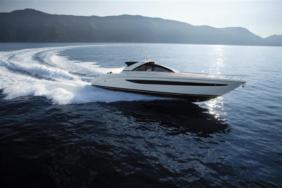
Feed your need for speed with Dana, a 68’ Riva Ego Super for sale. Launched in 2012, this vessel cuts through the waves at 35 knots, topping out at 39 knots. With a sexy profile that turns heads everywhere she goes, Dana offers all the comforts of home in her luxurious 3-stateroom layout. Bring all offers for this 2012 68’ Riva Yacht priced to sell with an asking price of 2 000 000 € EUR. Contact Joe Marino at 954-328-2059 or email him at [email protected] for more information.
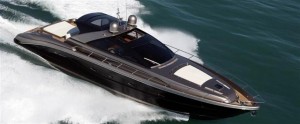
If you are looking at yachts for sale , or thinking about selling your yacht , it is always wise to have an experienced broker representing your interests throughout the deal. Contact Atlantic Yacht & Ship at 954.921.1500 or click here .
Categories for this Article
- luxury yachts
Explore Articles by Category
- 42Yellowfin
- AY&S News
- Bertram Yachts
- Boat Inventory
- center consoles for sale
- Custom Motor Yacht
- Florida Motor Yachts
- Florida Sport Fishing
- Fort Lauderdale News
- Fort Lauderdale Yachts
- Leopard Yacht
- Luxury Yacht Charter
- Maritime Industry
- Miami Yacht Show
- Motor Yacht Detailing & Maintenance
- Motor Yacht for Sale
- Navigator Yacht
- Palm Beach Yacht
- Pearl Yacht
- Pre Owned Motor Yachts
- Quality Motor Yachts
- Sabre Yacht
- Sport Fishers
- sportfish for sale
- Tri Deck Motor Yacht
- Uncategorized
- Viking sport fish
- World Travel
- Yacht Shows
- Yachting News
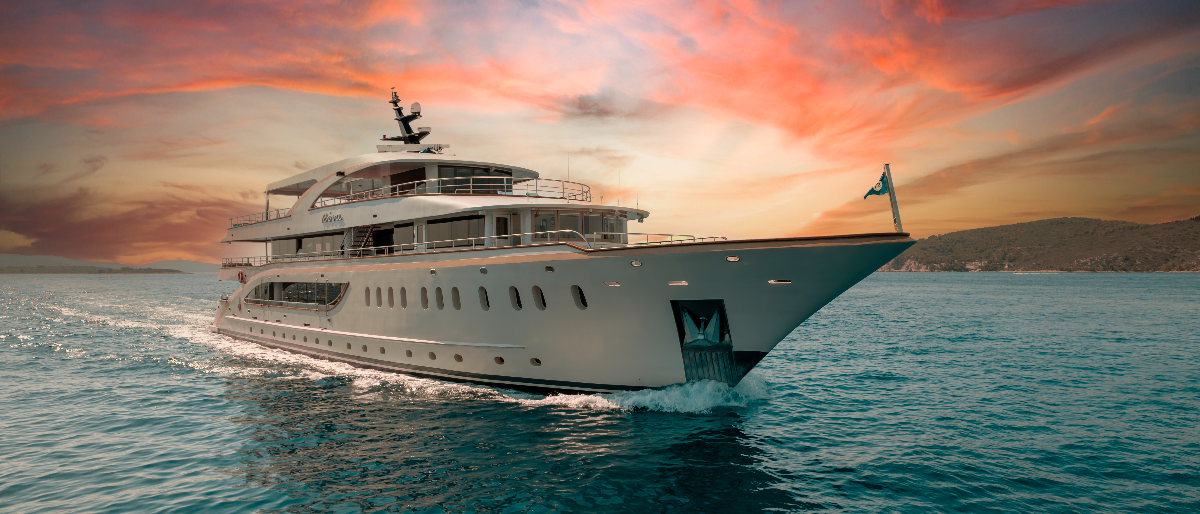
Introducing the Riva, an elegant yacht designed to offer superior comfort and luxury for a total of 36 guests. With 18 well-appointed, air-conditioned en suite cabins, the Riva ensures ample personal space for all, allowing guests to fully enjoy their journey. The main saloon boasts a dining area for a comfortable dining experience. Measuring an impressive 48 meters in length, the Riva offers generous space and comfort, all complemented by a professional crew of 10 dedicated to attending to your every need.
The expansive sun deck provides the perfect spot for sunbathing and relaxation, equipped with sun loungers and a jacuzzi to enhance your experience. Whether you're planning a family vacation, a romantic getaway, or a corporate retreat, the Riva presents an ideal choice for those seeking a luxurious and comfortable maritime adventure.
WHAT OUR GUESTS SAY:
-NO REVIEW FOUND--
Great Deck Space
Great For Larger Groups
TOYS & TENDERS
-NO TOYS FOUND--
-NO TENDERS FOUND--
DESTINATION
Summer :
Croatia & Montenegro
Winter :
From 60,000 EUR/Week
SIMILAR CHARTERS
€ 2,800
12.36 M
4 GUEST
$ 126,000
55.00 M
18 GUEST
€ 100,000
29.90 M
8 GUEST
€ 32,900
17.95 M
10 GUEST
SUBSCRIBE TO OUR NEWSLETTER
No time we call you, connect with us, subscribe to newsletter.
YACHT STORY is written in May 2021 in Antwerp, Belgium, encouraged by the need in the Benelux for a professional Partner for yacht charter services. The increasing demand of travelling and private escapes on a yacht organized from a to z by one contact person was an important stimulation to create this boutique charter company with a personal approach.
DESTINATIONS
OUR TRAVEL STORIES
PRIVACY POLICY
Zegersdreef 65 | 2930 Brasschaat | BELGIUM
+32 478 35 07 63
BE 0767.826.165
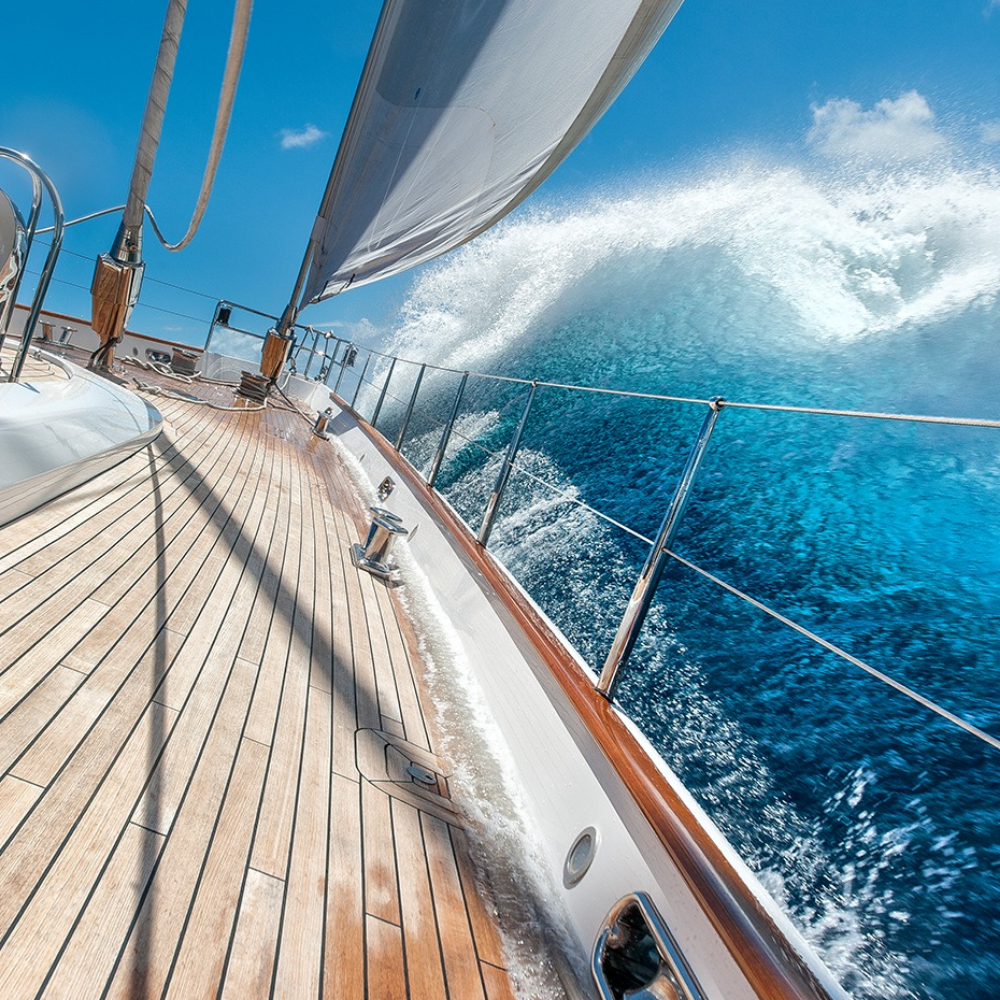
© Copyright 2021 Yacht Story
This website requires cookies to provide all of its features. By using our website, you agree to our use of cookies. More info

- en it 中文 es ru fr pt ja de
- il mito riva storia lifestyle riva destinations Riva - The movies
- yachts Open Sportfly flybridge dealer network Preowned
- superyachts division 50 metri 54 metri project a vision come true
- news ed eventi
- store riva boutique modelli in scala
- il mito riva
- riva destinations
- Riva - The movies
- dealer network
- superyachts division

- riva boutique
- modelli in scala

82' Diva New

102' Corsaro Super

110' Dolcevita
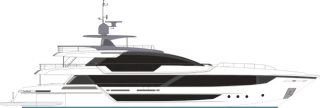
130' Bellissima New

El-Iseo New

Anniversario - Limited 1 of 18 - New

Aquariva Super

76' Bahamas Super

88' Florida

66' Ribelle

76' Perseo Super
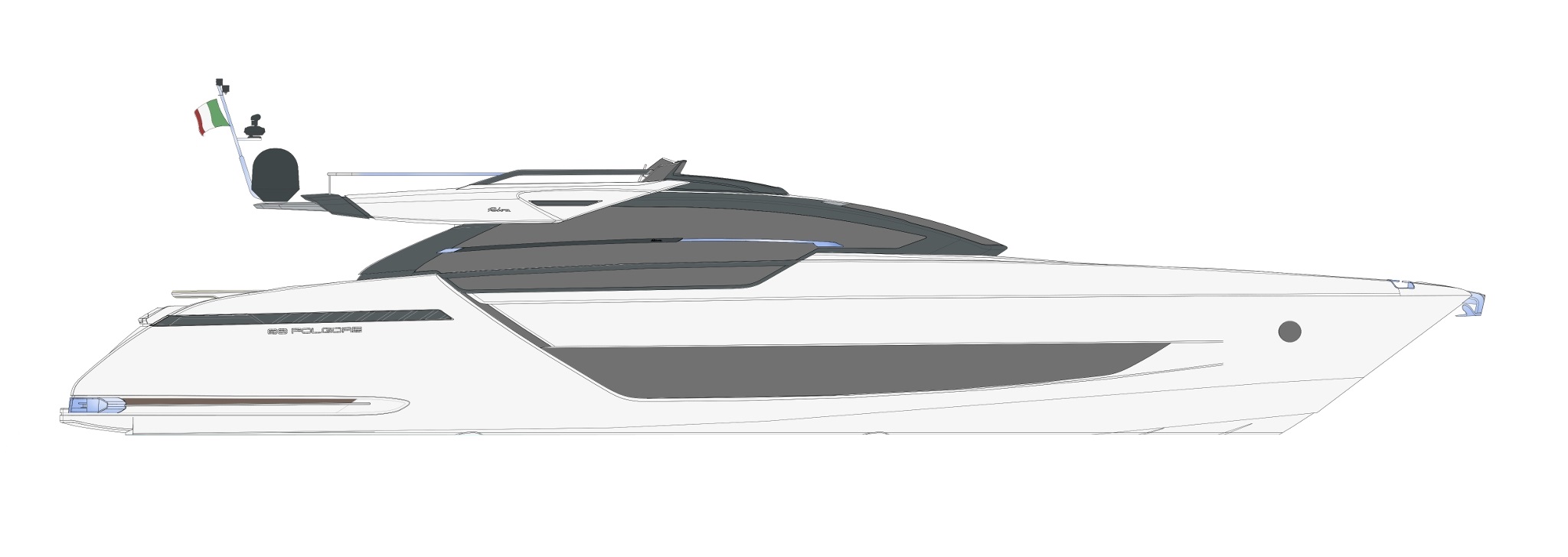
88' Folgore

Salone Nautico Venezia 2024
Riva ha il piacere di darvi il benvenuto al Salone Nautico Venezia 2024 dal 29 maggio al 2 giugno.
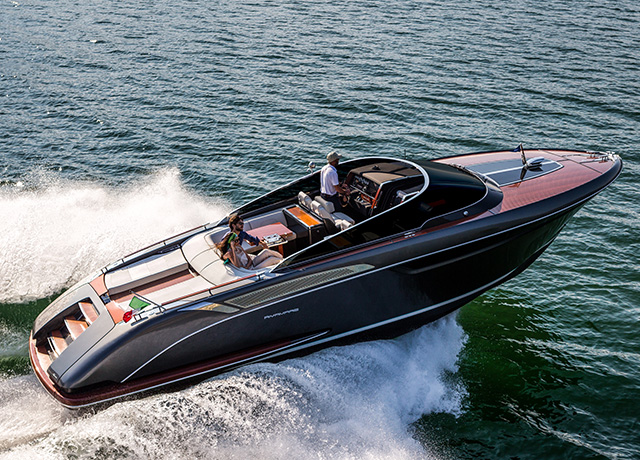
23 aprile 2024
L’innovazione nautica di Ferretti Group al Singapore Yachting Festival con due APAC premiere firmate Wally.
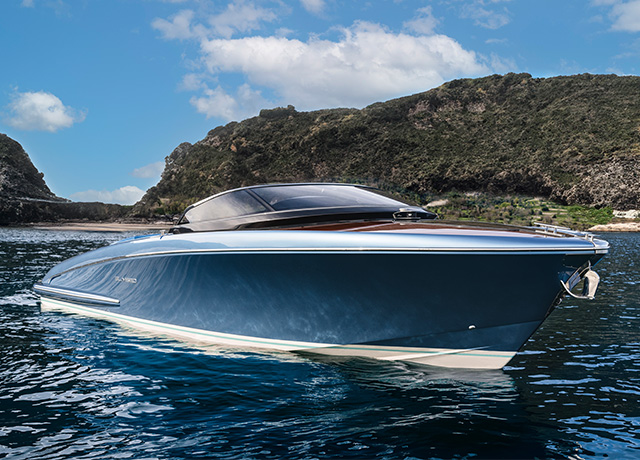
10 aprile 2024
La sostenibilità del full electric e lo stile inconfondibile: è il nuovo Riva El-Iseo.
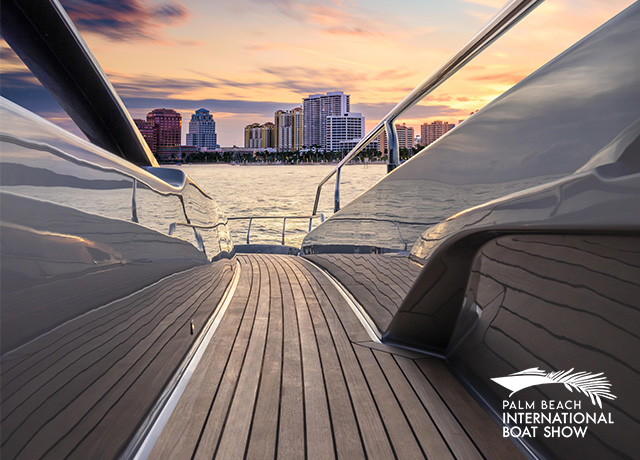
21 - 24 marzo 2024
Palm Beach International Boat Show 2024
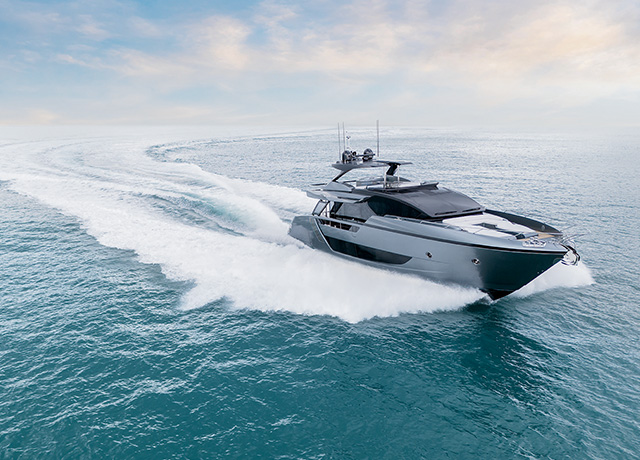
19 marzo 2024
Ferretti Group al Palm Beach International Boat Show con sei barche straordinarie.
- Press Center
- Riva anniversary
- Segnalazioni Whistleblowing

Ferretti S.p.A.
PI e CF 04485970968 Sede Legale Via Irma Bandiera, 62 – 47841 Cattolica (RN) Italia REA RN 296608 – Nr . Registro Imprese 04485970968 Capitale Sociale: € 338.482.654,00 i.v. PEC: [email protected]

Cookies on our site
Maggiori informazioni
Cookie Center
Su questo sito web utilizziamo cookie tecnici necessari alla navigazione e funzionali all’erogazione del servizio. Previo consenso, utilizziamo i cookie di profilazione per fornirti un’esperienza di navigazione sempre migliore, per facilitare le interazioni con le nostre funzionalità social e per consentirti di ricevere anche comunicazioni di marketing aderenti alle tue abitudini di navigazione e ai tuoi interessi. Puoi esprimere il tuo consenso ed accettare tutti i cookie di profilazione cliccando su ACCETTA oppure puoi rifiutarne l’installazione cliccando su RIFIUTA . Per ottenere maggiori informazioni sui cookie utilizzati visita la nostra Cookie Policy.
sempre attivi
- Bahasa Indonesia
- Slovenščina
- Science & Tech
- Russian Kitchen
A taste of Krasnodar cuppa

Krasnodar's are the oldest tea plants in Russia, and the older the plant, the better the tea it produces. Source: Mikhail Mordasov / RIA Novosti
Guests to the Winter Olympics are probably aware of the region’s unique cuisine, given Sochi’s long history as a port and its proximity to Georgia. But less well known is the area’s unique Krasnodar tea blend. This 150-year-old tea possesses strong healing properties, and its exquisite aroma resembles that of China's elite Lansing teas.
In the 18th century, the Russian and British empires together held a monopoly on the global tea trade. At the time, there were two ways to get to China, the homeland of tea. The sea trade routes passed through British-controlled Nanking, while the overland route, through Kyakhta, led to Russia. Russian tea merchants did not fear competition from the British.
They considered the tea that arrived in Russia far superior to that the British consumed because of the form of transportation. The heat and humidity of the southern seas, which tea clippers would take weeks to cross, ruined the delicate tea leaves.
By contrast, overland transportation only improved tea's qualities. True connoisseurs would pay a higher price for products offered by the Russian importers.
When the British started cultivating tea in India and Ceylon (Sri Lanka), the Russians, too, decided to expand their production base. The first attempts to acclimatize tea plants in what was then the southern fringe of the Russian Empire, in Georgia and Azerbaijan, were made in the 19th century.

The experiment proved a success: the Russian tea plantations yielded their first crops in the early 20th century, although the quality of the local tea blends left much to be desired. The local soils were too inferior to hope for anything better. The only advantage of the Georgian and Azeri teas was their relative cheapness.
Then Judas Koshman entered the scene. A mysterious figure whose early life remains largely unknown, Koshman is believed to have come from a small Jewish settlement in Ukraine to earn his keep working tea plantations in Georgia. In the early 20th century, when he was already 60 years old, Koshman found himself in the tiny mountainous settlement of Solokhaul near Sochi.
He used the money saved from working on a tea plantation in Georgia to buy a small plot of land. Koshman and his family started acclimatizing tea plants brought from Georgia. Koshman’s neighbours questioned his endeavour.
In the 1870s, agriculturists had shown that the North Caucasus was too cold for growing tea.
However, it took the tea plants introduced from Georgia just four years to take root to such an extent that they no longer needed to be wrapped for the winter, even though temperatures in Solokhaul may drop to 10 degrees Farenheit in January.
Ten years later, in 1913, the Koshmans celebrated their first yield of tea. What later became known as the Krasnodar tea blend (after the name of the region – Krasnodar Territory) has the sweetness, beautiful dark-amber tint and flowery aroma of the best Chinese Lansing teas.
The harsh North Caucasus climate may affect the size of the crop, but it is thanks to the climate that the local tea contains more healthful substances than the Chinese equivalents.
Recognition did not come easily to Koshman. In his modest house, which has been turned into a museum, there is a vast collection of non-committal replies from the Russian Academy of Sciences: St. Petersburg scholars dismissed Koshman's reports on the Krasnodar tea blend as hoaxes, while the Georgian tea lobby set the police on their potential rival.
Koshman's wife had to bail him out of prison at one point. It was not until the Soviet era, when Koshman was already over 70, that he received a gold medal at an agricultural exhibition.
The hand-picked Koshman House tea is a truly exclusive product. Koshman's are the oldest tea plants in Russia, and the older the plant, the better the tea it produces. Koshman's teas eventually spread across the mountainous area of greater Sochi in the 20th century.
Krasnodar teas were on sale in the Soviet era, but they did not enjoy any particular popularity because the tea leaves were picked mechanically, robbing the tea of its unique properties.
Even during Perestroika, when the once-gigantic Koshman plantation fell into decay, the Krasnodar tea blend retained its reputation as a unique hand-picked product, and continued to be manufactured in small batches.
It remained the northernmost tea in the world until 2012, when the UK gathered its first locally grown crops.
All rights reserved by Rossiyskaya Gazeta.
to our newsletter!
Get the week's best stories straight to your inbox
This website uses cookies. Click here to find out more.
- Yekaterinburg
- Novosibirsk
- Vladivostok
- Tours to Russia
- Practicalities
- Russia in Lists
Rusmania • Deep into Russia
- Krasnodar Territory
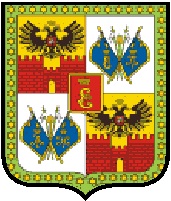
Krasnodar was founded as Yekaterinodar (“Catherine’s Gift”) as a gift to the Kuban Cossacks, having previously been part of Circassian lands. After the Revolution it was renamed Krasnodar (“Red Gift”) to get rid of the imperial connotations. Today the city is still considered the centre of the Kuban Cossacks and is proud of this link, with many related sights.
It is a major economic and cultural centre in the region and as such has good transport links with other Russian cities. From Krasnodar it is easy to visit the Republic of Adygea and its capital Maikop which is located inside the Krasnodar Territory.
Plan your next trip to Russia
Ready-to-book tours.
Your holiday in Russia starts here. Choose and book your tour to Russia.
REQUEST A CUSTOMISED TRIP
Looking for something unique? Create the trip of your dreams with the help of our experts.

IMAGES
COMMENTS
Entra nella storia del mito - Riva Yacht. Leggenda contemporanea. La storia di Riva comincia all'insegna di quel sapere fare, unico e inimitabile, che è ancora il segreto del suo primato di stile e bellezza. È il 1842 e sul Lago d'Iseo un giovane maestro d'ascia compie un vero miracolo, rimettendo in sesto gran parte delle barche dei ...
Storia. Il cantiere nasce per opera del maestro d'ascia Pietro Riva nel 1842 a Sarnico, sulla sponda occidentale del Lago d'Iseo.. 1880: Ernesto Riva introduce il motore a scoppio.. 1912: il primo maggio Serafino Riva, su uno scafo da corsa spinto da un motore fuoribordo prodotto da una ditta di Genova, supera i 24 km all'ora.. 1922: il 24 febbraio nasce Carlo Riva.
Potrebbe anche essere più dello spirito del tempo, dell'ideologia, del concetto, della bellezza, una fusione di stile e funzione che rendono Riva uno dei nomi più desiderabili di yacht. È una straordinaria storia di serendipità e talento quella che ha portato alla nascita delle barche Riva.
Carlo Riva was born in Sarnico on February 24, 1922, in the period when the first racing powerboats were being built, and from a young age was driven by a boundless passion for boats and boatyards. He joined the family business when he was still very young, following in the footsteps of his father Serafino, and before him his grandfather and ...
Di Micol Passariello Pubblicato: 17/09/2022. Courtesy Cameron Hammond. Quando si parla di glamour e di stile in mare, non c'è niente di più attraente dell'Aquarama. Ideato dal mitico Carlo Riva ...
1. Tritone. The first twin-engine classic range Riva yacht was the Tritone, in build from 1950-1966. While 221 of the standard Tritone version were delivered, far fewer of the far more desired Super Tritone came into being, with only 21 hitting the water. At nearly eight metres LOA, the Super Tritone was a long, powerful version of Riva's ...
Riva Yacht. The fiberglass era and the evolution of the construction site (1970 - 1999) G.S.C. Riva - Rudy, one of Riva's first fibreglass models by Photographer Federico PatellaniMuseimpresa. Fiberglass. Carlo Riva was an innovator not only in design and style, but also in materials and technologies. From one of his many trips to America ...
From its origins on Lake Como with Pietro Riva, to the era of the 'Bella Vita' and industrial development, through to the present day, in a fascinating journey through history and images of moments that have made history. 1842 - 1930s. Origins. HISTORY. 1930s - '40s. The age of racing. HISTORY. 1950s - '60s. Series-produced boats.
The Riva Yachts history began in 1842 when Pietro Riva, a 20-year-old carpenter, left Sarnico, Italy to repair boats at Lake Iseo. His exceptional woodworking skills on a severely damaged boat led to additional work in the region to repair and build new boats. Riva's Sarnico Shipyard, 1842. As he completed orders for fishing and row boats, his ...
A Riva yacht is always instantly recognizable, as the shipyards roots are intertwined with tradition, innovation and love for crafting unique motorboats. Today, the unmistakable fleet Riva includes the flagship series 110' Dolcevita, 100' Corsaro, 88' Florida, 88' Domino Super, 76' Perseo, 76' Bahamas, 66' Ribelle, 63' Virtus ...
2022 marked both Riva's 180th anniversary and the Aquarama's (the shipyard's most sought after model) 60th birthday. ... Back in the days we spent summertime in the Aegean Sea with our motor yacht — also designed by Carlo Riva — pulling the wooden Lipicar as a tender for small-range boat trips; fishermen were often approaching us for ...
While every Riva—indeed, every large yacht—these days incorporates large glass ports, Race's owner felt it was especially important for the 50-Meter to have them, notably along the main and upper decks. Additionally, in an interesting twist on an indoor-outdoor area, the covered alfresco dining area aft on the upper deck has slide-open ...
La storia del mitico cantiere che ha realizzato motoscafi immortali espressione del Made in Italy. Lo storico cantiere di motoscafi Riva è tra i più rappresentativi dell'eccellenza del Made in Italy in campo nautico. Nato da un'avventura imprenditoriale che ha origine nel 1852 a Sarnico (foto sotto), sulla sponda occidentale del Lago d'Iseo ...
The builder's latest fibreglass flagship, the 33.5 metre 110' Dolcevita, is specifically designed in the hopes of answering this query with a resounding yes. "Bringing the iconic Riva styling into a larger boat was the target since the beginning of the project," says Giordano Pellacani, head of sales and marketing at Riva, under the ...
For more information, call Mark Meyer at 305-677-9137 or email him at [email protected]. Preowned 68' Riva Yacht for sale. Feed your need for speed with Dana, a 68' Riva Ego Super for sale. Launched in 2012, this vessel cuts through the waves at 35 knots, topping out at 39 knots. With a sexy profile that turns heads everywhere ...
Introducing the Riva, an elegant yacht designed to offer superior comfort and luxury for a total of 36 guests. With 18 well-appointed, air-conditioned en suite cabins, the Riva ensures ample personal space for all, allowing guests to fully enjoy their journey. The main saloon boasts a dining area for a comfortable dining experience.
I modelli della gamma Riva esprimono in grande stile l'anima del mito. Scopri la nuova era dello yacht design. In a variety of different lengths and models with a shared spirit of performance, safety and exclusive style, the Riva range expresses the soul of this legendary brand to sublime effect.
For those keeping track and salivating at home, their 130 foot long, five suite toy is a Riva 130 Bellissima Yacht. Bellissima, indeed, because she's Italian. Bellissima, indeed, because she's ...
Krasnodar Krai is located in the southwestern part of the North Caucasus and borders Rostov Oblast in the northeast, Stavropol Krai and Karachay-Cherkessia in the east, and with the Abkhazia region (internationally recognized as part of Georgia) in the south. The Republic of Adygea is completely encircled by the krai territory. The krai's Taman Peninsula is situated between the Sea of Azov in ...
What later became known as the Krasnodar tea blend (after the name of the region - Krasnodar Territory) has the sweetness, beautiful dark-amber tint and flowery aroma of the best Chinese Lansing ...
Krasnodar is the largest city and the administrative centre of Krasnodar Krai, Russia.The city stands on the Kuban River in southern Russia, with a population of 1,121,291 residents, and up to 1.226 million residents in the Urban Okrug. In the past decade Krasnodar has experienced rapid population growth, rising to become the thirteenth-largest city in Russia, and the second-largest city in ...
Krasnodar was founded as Yekaterinodar ("Catherine's Gift") as a gift to the Kuban Cossacks, having previously been part of Circassian lands.